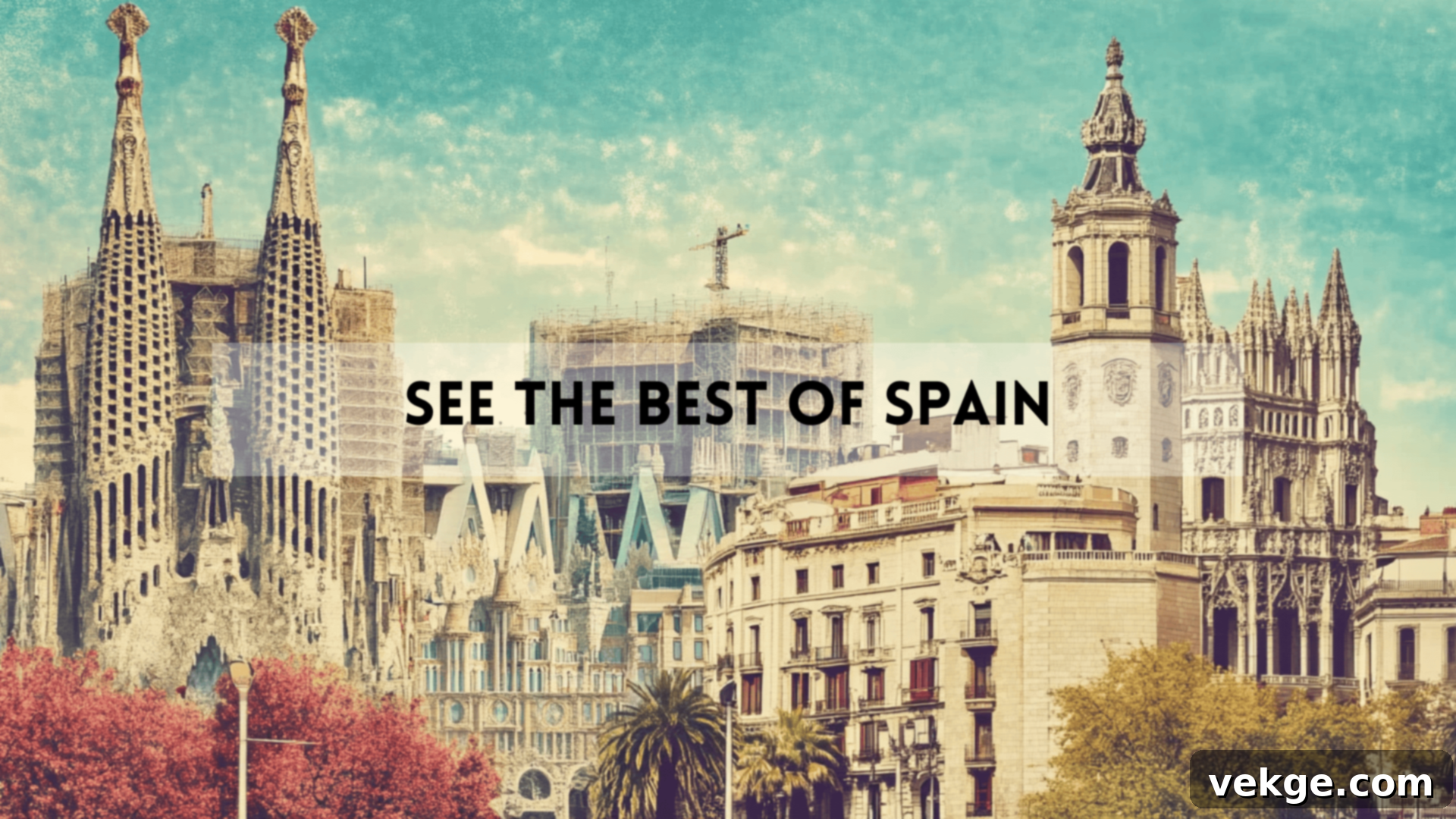Discover Spain’s Architectural Wonders: A Guide to Its Most Iconic Buildings and Landmarks
Spain, a country brimming with a rich tapestry of history, diverse cultures, and awe-inspiring beauty, offers an unparalleled journey through architectural time. Whether you’re meticulously planning a trip to this stunning Iberian nation or simply possess a deep appreciation for magnificent structures, this comprehensive list is specifically tailored for you.
The Spanish landscape is adorned with an astonishing array of architectural marvels. From the imposing grandeur of ancient castles and the spiritual majesty of colossal cathedrals to the strikingly unique and imaginative houses born from artistic genius, the options for exploration seem limitless. However, with such a wealth of breathtaking sites spanning millennia and styles, deciding which ones to prioritize can be an exciting, yet daunting, challenge for any traveler or enthusiast.
That’s precisely why we’ve curated this definitive guide: a meticulously selected yet exhaustive compilation of Spain’s most famous and architecturally significant sites. This list proudly showcases a diverse spectrum of styles, spanning from ancient Roman and Moorish influences through the solemnity of the Gothic and Renaissance periods, to the revolutionary Modernism of Gaudí, and the cutting-edge designs of contemporary architecture. Prepare to be enchanted by buildings featuring intricate, sophisticated patterns, vibrant, sun-drenched walls, and innovative, often gravity-defying, shapes.
This guide serves as your ultimate companion, bringing together the absolute must-see architectural highlights of Spain, all conveniently located in one place. As you delve into these wonders, exploring their histories, unique features, and cultural significance, which masterpiece will ultimately capture your imagination the most? Keep reading to unveil your favorites and embark on an extraordinary visual journey through Spain’s unparalleled architectural heritage.
Spain’s Most Iconic Architectural Masterpieces and Historical Landmarks
Spain proudly stands as a global hub for some of the world’s most iconic and historically significant buildings. Every corner of this diverse country reveals a captivating blend of history, culture, and ground-breaking design, making it a dream destination for architecture enthusiasts and history buffs alike. From ancient fortifications to futuristic art complexes, the sheer variety of Spanish architecture tells a compelling story of its past and its enduring spirit of innovation.
Islamic & Moorish Architecture: Echoes of Al-Andalus
A significant period in Spain’s history saw large parts of the country flourish under Muslim rule, particularly during the era of Al-Andalus. This epoch left an indelible mark, giving rise to an architectural legacy characterized by exquisite detail, innovative engineering, and a profound connection to nature and geometry. These buildings often feature characteristic horseshoe arches, serene fountains, intricate geometric tilework (azulejos), and tranquil, enclosed gardens (patio style), creating spaces of peace and beauty. Here’s a closer look at five paramount examples of this mesmerizing architectural tradition.
1. Alhambra – Granada
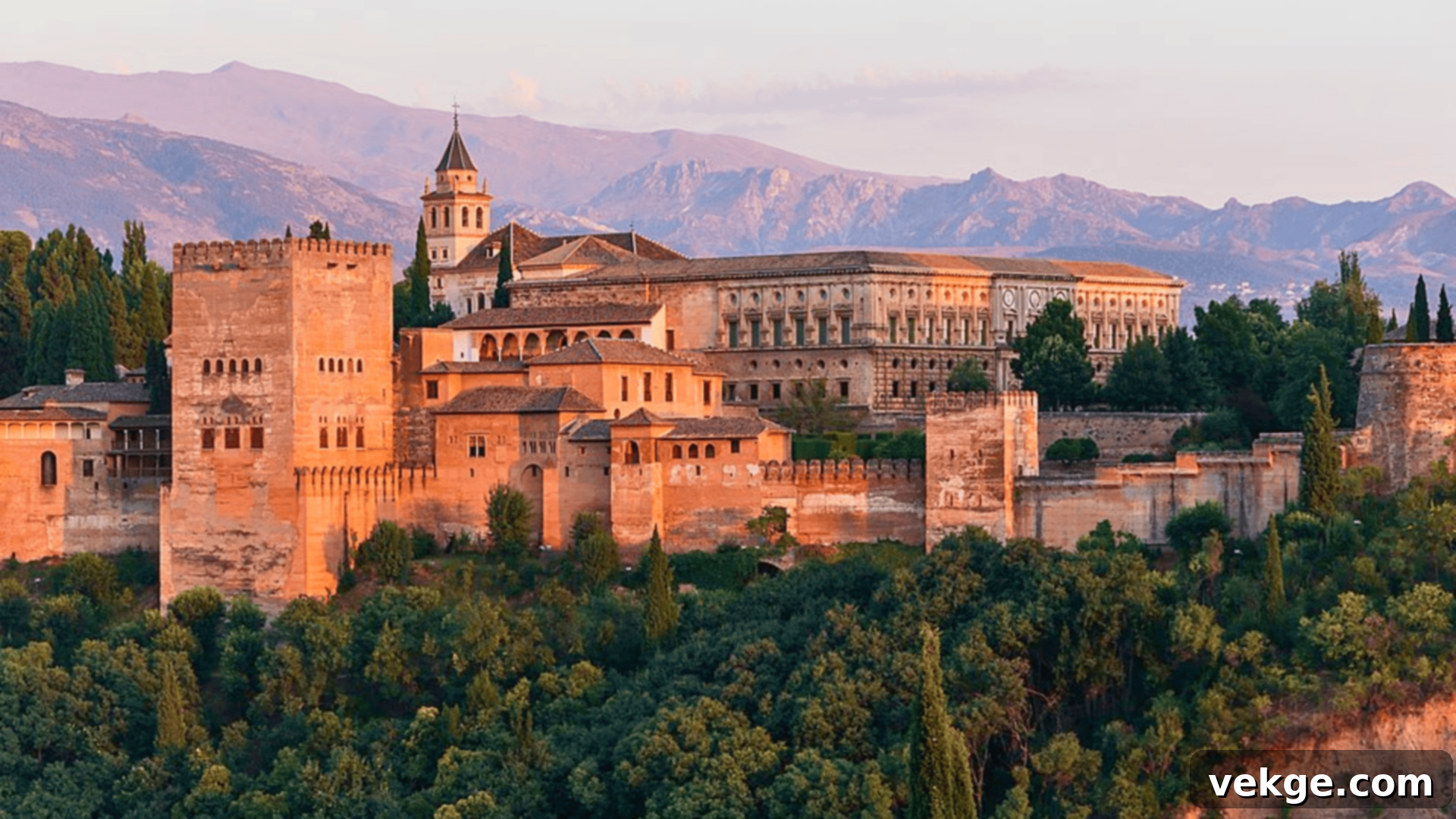
Perched majestically on a hilltop overlooking Granada, the Alhambra is a legendary palace and fortress complex that dates back to the 13th century, primarily built by the Nasrid dynasty. Recognized as a UNESCO World Heritage site, it stands as the zenith of Islamic architecture in Spain. Its allure lies in its incredibly detailed stucco carvings, the delicate beauty of the Nasrid Palaces, the serene courtyards like the Patio de los Leones (Court of the Lions) with its intricate fountain, and the breathtaking panoramic views of the city and the snow-capped Sierra Nevada mountains. The Alhambra is not just a building; it’s a poetic fusion of light, water, and intricate artistry, meticulously designed to evoke paradise on Earth, making it a profound symbol of Moorish sophistication and engineering prowess.
Best Times to Visit: April to June or September to October offer mild weather and fewer crowds, perfect for exploring its vast complex and detailed interiors without discomfort.
Visiting Hours: Open daily with timed tickets. Both day and night visits are available, each offering a unique and magical perspective of its beauty. Booking well in advance is essential due to high demand.
2. Mezquita-Cathedral (Mosque-Cathedral of Córdoba) – Córdoba
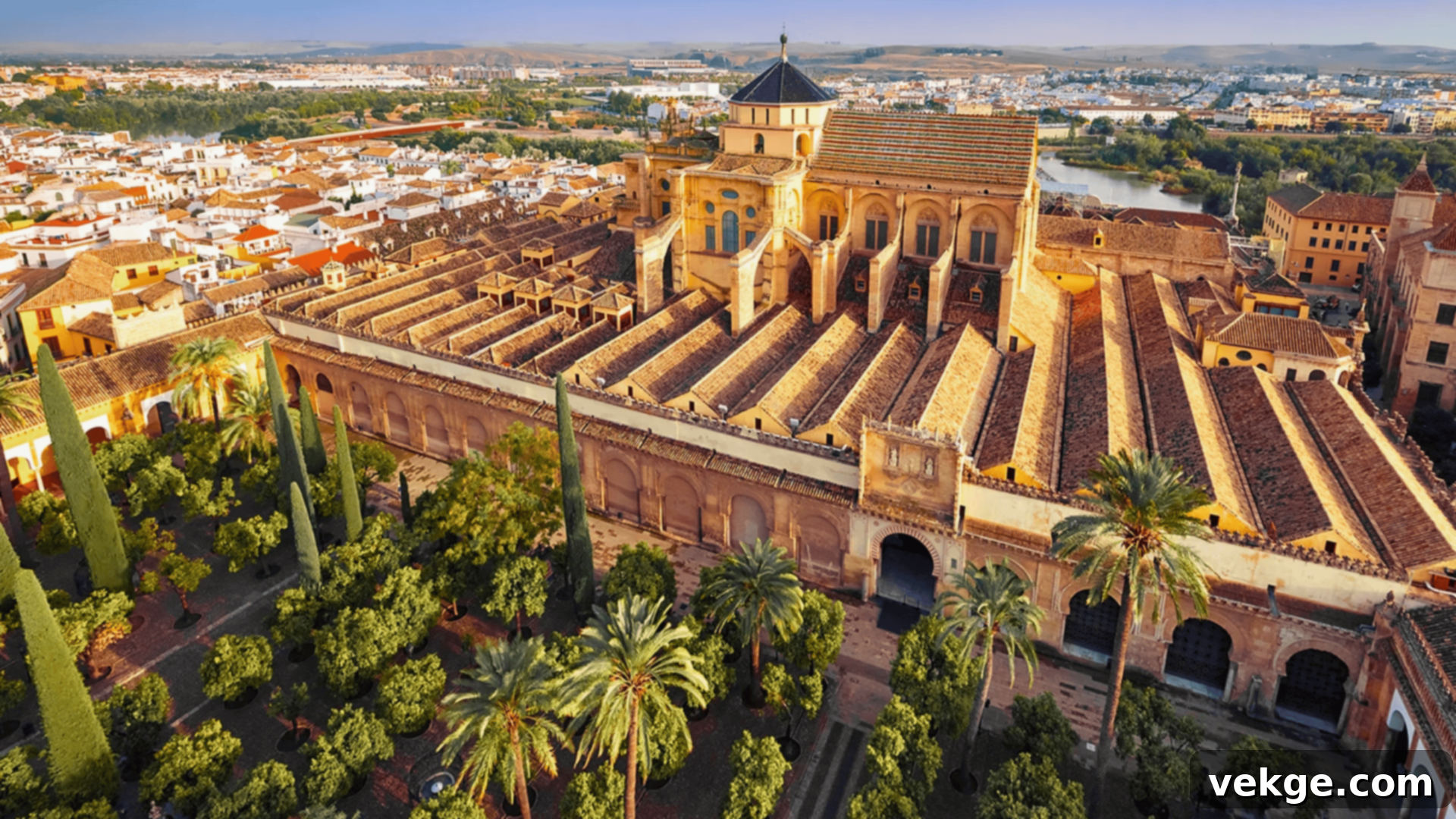
A truly unique architectural marvel, the Mezquita-Cathedral of Córdoba began its life as a grand mosque in the 8th century, expanding significantly over subsequent centuries to become one of the largest mosques in the world. Following the Christian Reconquista, a stunning cathedral nave was reverently built right in its heart, creating an astonishing fusion of two distinct faiths and architectural styles that coexist in fascinating harmony. Inside, visitors are transported to a ‘forest’ of over 850 distinctive red-and-white striped horseshoe arches supported by Roman and Visigothic columns. Its breathtaking mihrab, a prayer niche, is a masterpiece of Byzantine mosaic work, making this site a profound symbol of Spain’s complex religious, cultural, and architectural history—a testament to coexistence and transformation.
Best Times to Visit: Spring, especially April and May, is ideal thanks to the pleasant weather and the vibrant local festivals, enhancing your visit to this magnificent site.
Visiting Hours: Open daily. Free entry is sometimes offered early in the morning, a fantastic opportunity to experience its tranquility and grandeur without the main crowds.
3. Alcazaba of Málaga – Málaga
The Alcazaba of Málaga is a magnificent palatial fortification that majestically dominates the city’s skyline from its strategic hilltop position. Constructed in the 11th century during the Taifa period by the Hammudid dynasty, it served as a formidable defensive structure for the city, ingeniously integrating with the Roman theatre remains at its base. This incredibly well-preserved Muslim fortress in Spain showcases a sophisticated series of inner and outer walls, formidable defensive towers, and beautiful terraced gardens adorned with fragrant fountains and citrus trees. Its intricate arches and courtyards offer a vivid glimpse into the luxurious lifestyle of its former Moorish rulers, while providing spectacular panoramic views over Málaga’s bustling port and dynamic cityscape. It stands as a testament to advanced military architecture beautifully blended with aesthetic charm.
Best Times to Visit: March to May or September to November are great times to go, offering comfortable temperatures for extensive exploration of the complex and surrounding areas.
Visiting Hours: Open every day, usually from 9 AM to 8 PM in summer, and until 6 PM in winter. Always check current timings and specific holiday schedules.
4. Aljafería Palace – Zaragoza

Nestled in Zaragoza, the Aljafería Palace is a fortified medieval Islamic palace built in the 11th century, a rare and exquisite example of Islamic Taifa art in northern Spain. This stunning monument showcases the opulence and refined artistic taste of the Banu Hud dynasty. Its architectural highlights include the intricate multi-lobed horseshoe arches, stunning geometric patterns, and the serene Patio de Santa Isabel (Courtyard of Saint Isabel) which offers a peaceful central space. Beyond its historical beauty, the palace uniquely houses the regional parliament of Aragon today, making it a living monument where ancient history seamlessly meets modern governance. Its Troubadour Tower, the oldest part of the complex, is believed to have inspired Giuseppe Verdi’s opera “Il Trovatore.”
Best Times to Visit: Visit in spring or fall to avoid the intense summer heat and enjoy comfortably mild weather, ideal for exploring the city of Zaragoza.
Visiting Hours: Open daily, though hours may vary, especially around holidays and parliamentary sessions. It’s advisable to check ahead for specific timings.
5. Generalife Gardens – Granada
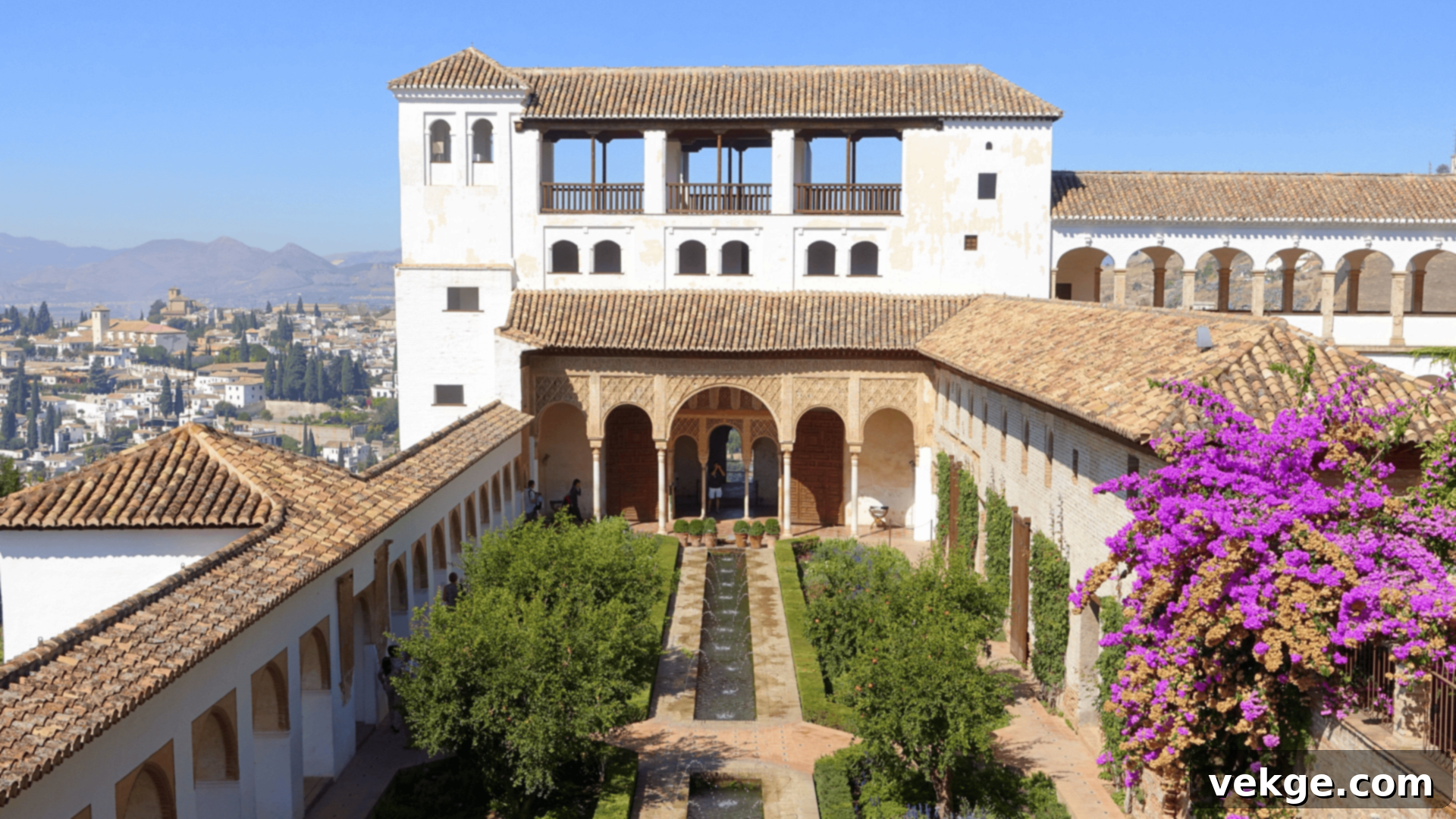
Adjacent to the grand Alhambra, the Generalife (meaning “Architect’s Garden” or “Garden of Paradise”) served as the serene summer palace and country estate for the Nasrid rulers of Granada. These exquisite gardens are a testament to the sophisticated Moorish landscape design, where water, shade, and greenery were meticulously used to create a tranquil oasis, embodying the concept of a terrestrial paradise. With its iconic Water Stairway, the Patio de la Acequia (Court of the Water Channel) featuring fountains that dance with light and irrigate vibrant flowerbeds, the Generalife is a place of profound peace and natural beauty. It was designed for relaxation, contemplation, and seasonal retreats, offering a harmonious contrast to the opulent interiors of the Alhambra itself, and is an integral part of the UNESCO World Heritage site.
Best Times to Visit: April to June is the absolute best time to witness the gardens in their full, breathtaking bloom and experience their vibrant colors and scents.
Visiting Hours: Open daily. Entry is frequently included with general Alhambra tickets, offering a comprehensive historical and natural experience across the entire complex.
Gothic, Romanesque & Medieval: Grandeur of Faith and Feudal Power
The Middle Ages in Spain were a period of intense religious fervor, political consolidation, and artistic innovation, deeply reflected in its architecture. This era produced buildings of awe-inspiring scale and intricate artistry, predominantly in the Romanesque and Gothic styles. Characterized by soaring tall towers, breathtaking stained-glass windows that flood interiors with ethereal light, and elaborate stone carvings depicting religious narratives or mythical creatures, many of these grand cathedrals continue to welcome millions of visitors and worshippers today, standing as enduring symbols of faith, human endeavor, and the rich history of medieval Spain.
6. Cathedral of Santiago de Compostela – Galicia
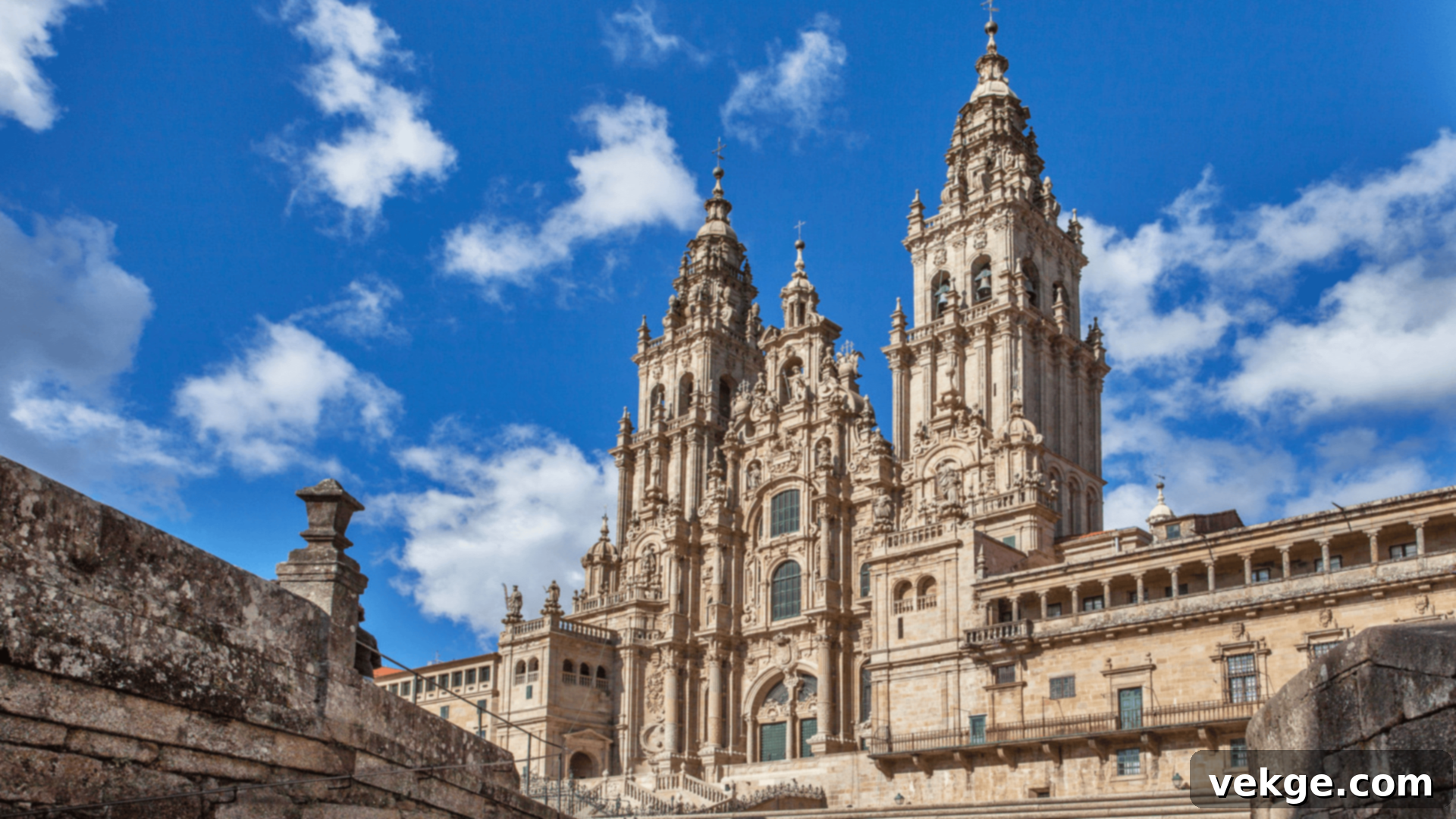
The magnificent Cathedral of Santiago de Compostela marks the revered culmination of the Camino de Santiago, one of the world’s most ancient and famous pilgrimage routes. While its exterior is adorned with splendid Baroque additions, particularly the Obradoiro façade, the core of the cathedral remains a profound masterpiece of Romanesque architecture. Its grand entrance, the Pórtico de la Gloria (Portico of Glory), features intricate 12th-century sculptures by Master Mateo that are considered a pinnacle of medieval art, depicting scenes from the Apocalypse. Pilgrims traditionally touch the statue of Saint James here as a sign of having completed their journey. With its towering spires and rich history as the supposed burial place of Saint James the Great, it represents a spiritual beacon and an enduring UNESCO World Heritage symbol of Christian faith and architectural evolution.
Best Times to Visit: Visit from May to October when the weather is favorable for travel and the town buzzes with the energy of arriving pilgrims, creating a vibrant atmosphere.
Visiting Hours: Open daily, typically from early morning to evening. Specific sections like the museum or Portico de la Gloria may have varied hours or require separate tickets.
7. Burgos Cathedral – Burgos
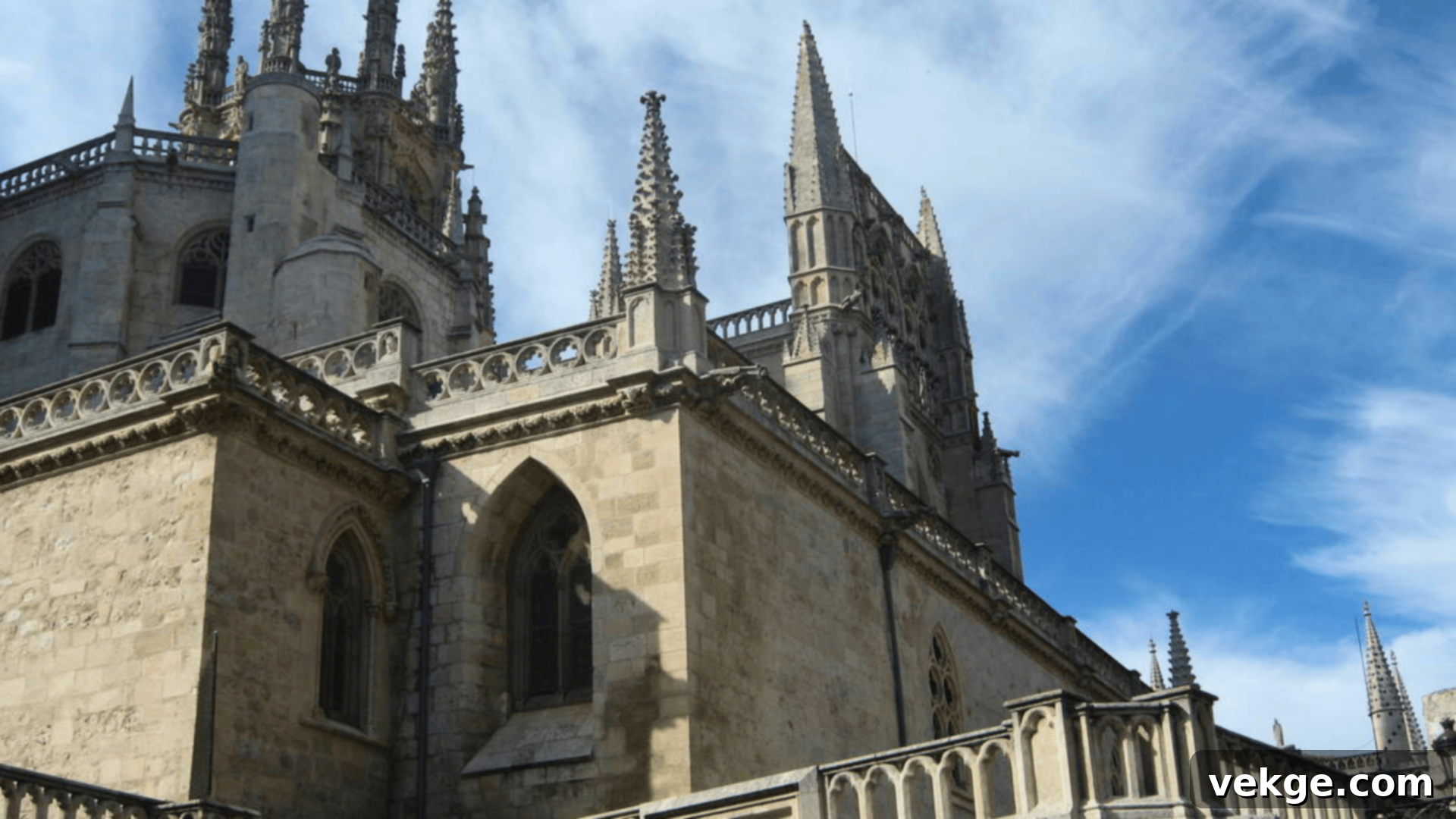
A designated UNESCO World Heritage site since 1984, Burgos Cathedral is an exceptional example of Gothic architecture, renowned for its unparalleled beauty and structural ingenuity. Initiated in 1221, its construction spanned over three centuries, resulting in a rich tapestry of styles, though predominantly inspired by French Gothic cathedrals. It is distinguished by its intricate twin spires that pierce the sky, exquisite rose windows, and a multitude of chapels adorned with masterpieces of painting and sculpture, including the stunning Chapel of the Constable. The cathedral also holds a significant place in Spanish history as the final resting place of El Cid, Spain’s legendary national hero, and his wife, Doña Jimena, making it a pivotal site for both art and history enthusiasts.
Best Times to Visit: Spring and fall are the optimal times to explore the cathedral and its surroundings, avoiding intense summer heat and larger crowds, providing a more comfortable experience.
Visiting Hours: Open every day, usually from 10 AM to 7 PM. Always check for special events, religious services, or holiday hours which might affect public access.
8. Segovia Cathedral – Segovia
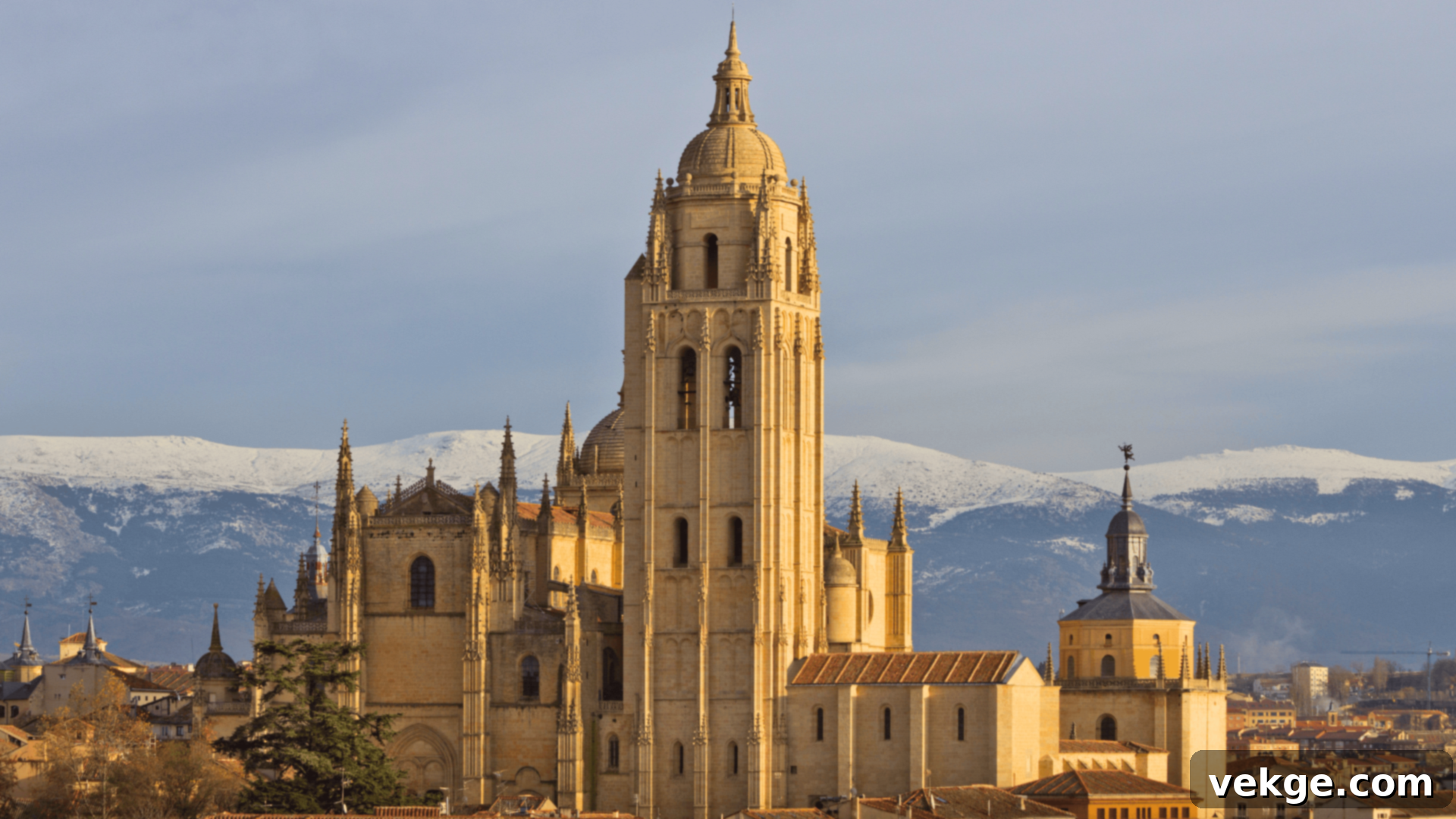
Affectionately known as the “Lady of Cathedrals,” Segovia Cathedral stands as one of the last major Gothic cathedrals built in Spain, with its construction beginning in 1525, at a time when Renaissance styles were already gaining prominence across Europe. Its impressive scale, majestically towering above the main square of Segovia, features high ceilings, delicate tracery, and a series of magnificent chapels housing a rich collection of religious art. The cathedral’s soaring central nave, adorned with beautiful stained glass and a grand altarpiece, provides a profound sense of spiritual elevation, truly encapsulating the late Gothic aesthetic with its distinct Spanish characteristics. Its imposing presence makes it a highlight of Segovia’s UNESCO-listed old town.
Best Times to Visit: May, June, or September offer the most pleasant weather for leisurely sightseeing around Segovia’s historic town, including its famous Roman aqueduct and Alcázar.
Visiting Hours: Open daily, though hours may subtly change with the seasons and religious observances. It’s best to confirm locally or on their official website.
9. Toledo Cathedral – Toledo
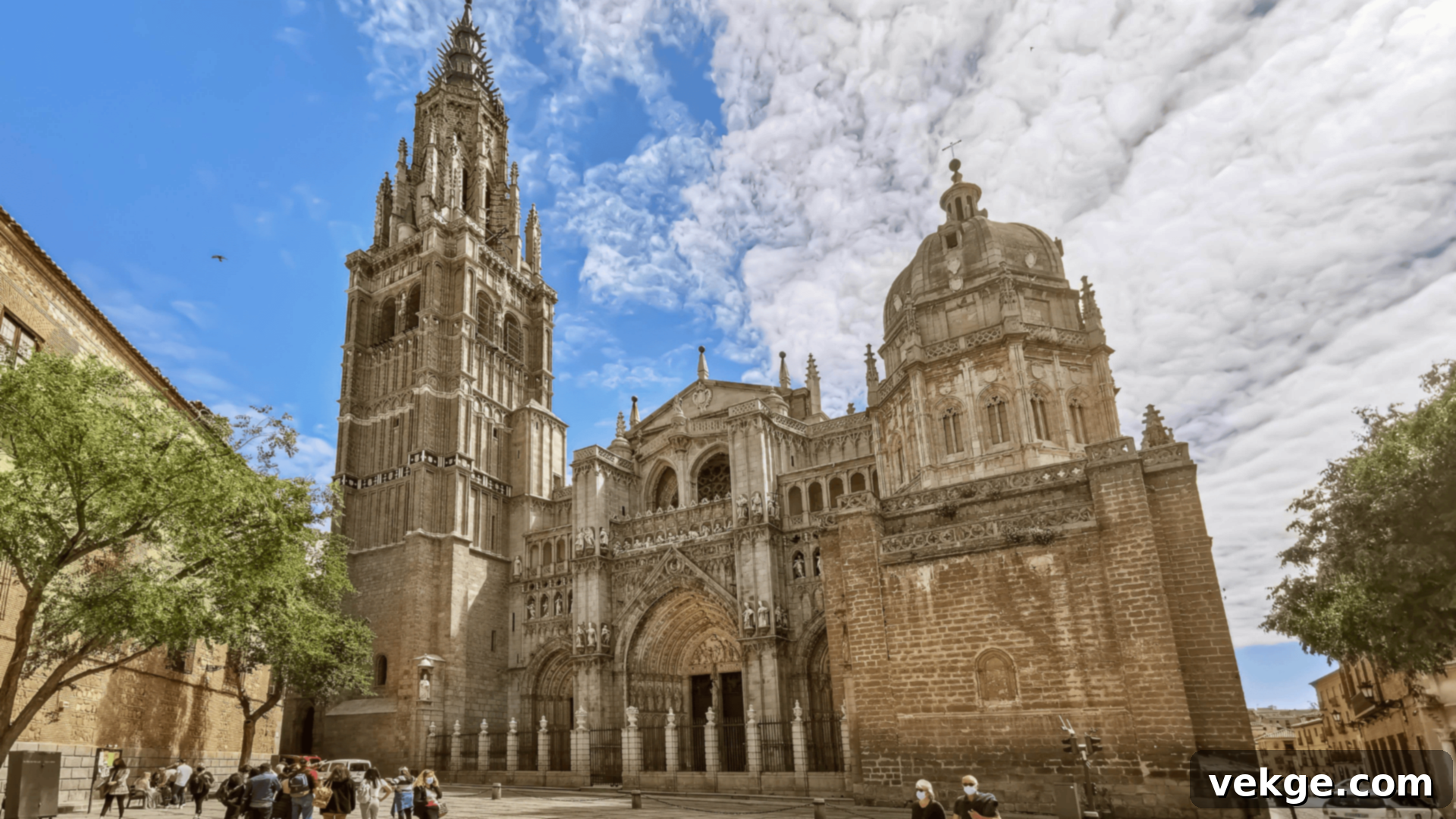
The Primate Cathedral of Saint Mary of Toledo is a colossal structure that beautifully encapsulates centuries of Spanish history and artistic evolution. Primarily Gothic in style, its construction began in the 13th century, incorporating subtle yet significant influences from Moorish (Mudejar) and Renaissance art, reflecting Toledo’s unique multicultural past. Inside, visitors are met with an astounding display of architectural grandeur: incredibly tall arches, breathtaking gold decorations, and an unparalleled collection of religious art, including masterpieces by El Greco, such as “The Disrobing of Christ.” Its impressive scale, the elaborate choir stalls, and intricate details make it one of Spain’s most significant cathedrals, mirroring the city’s historical role as a melting pot of Christian, Muslim, and Jewish cultures.
Best Times to Visit: Spring and early fall are ideal to enjoy mild weather and experience fewer tourist crowds in this popular UNESCO World Heritage city.
Visiting Hours: Open Monday to Saturday, often from 10 AM to 6 PM, with shorter hours on Sundays and holidays. Always verify specific timings.
10. Santa Maria del Mar – Barcelona
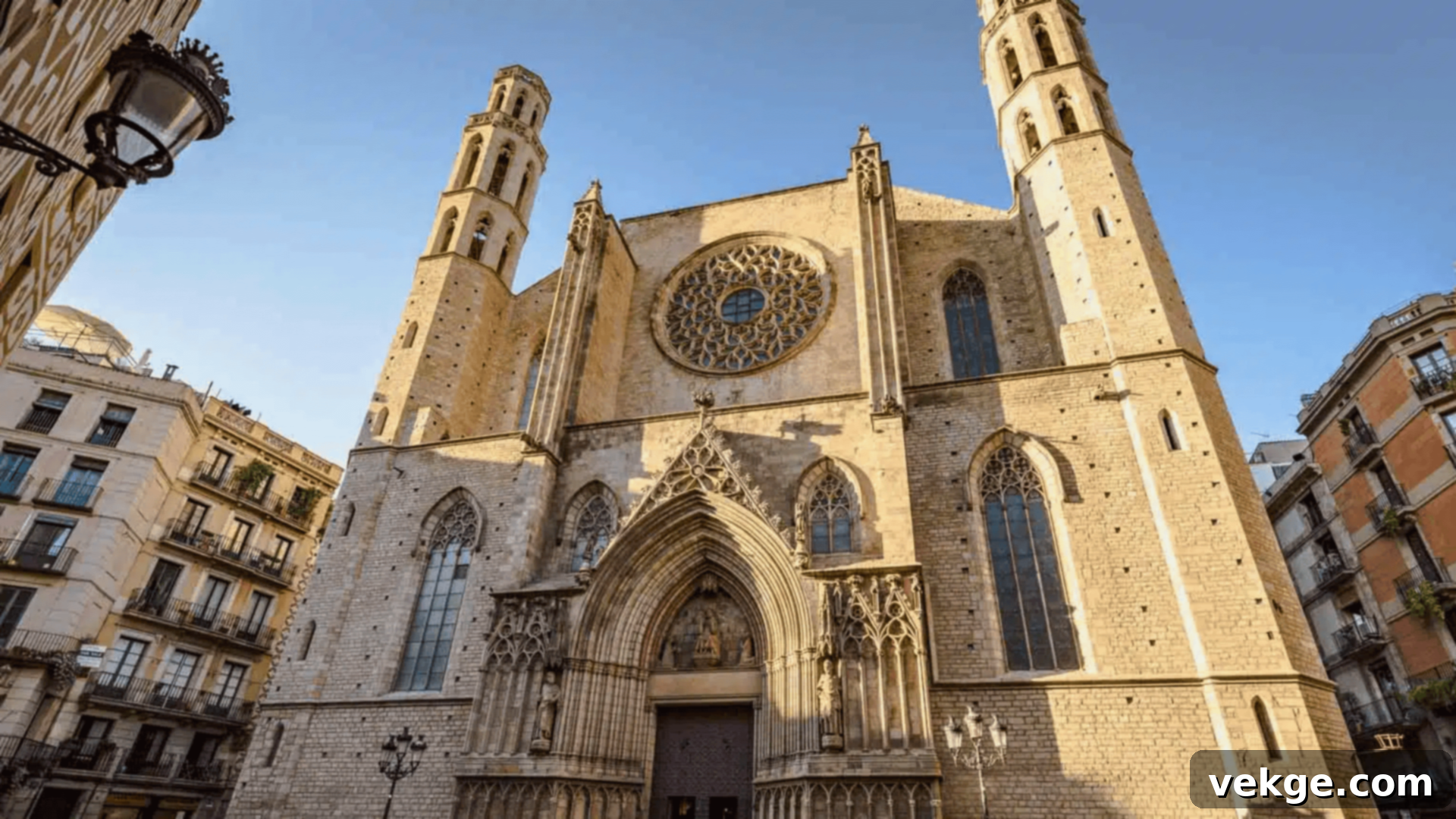
Known affectionately as the “Cathedral of the Sea,” Santa Maria del Mar is a stunning example of Catalan Gothic architecture, distinguished by its remarkable purity, unity, and harmonious proportions of style. Built by the city’s fishermen and dockworkers in the 14th century, it embodies the spirit and determination of Barcelona’s maritime community, often seen as a church built by the people, for the people. In contrast to other ornate Gothic cathedrals, Santa Maria del Mar is characterized by its clean lines, elegant and widely spaced columns, and a profound sense of open space and light that creates an immediate feeling of grandeur upon entry. Its beautiful stained glass windows and peaceful atmosphere make it a beloved spiritual and architectural gem for both locals and visitors alike, a tranquil oasis in the bustling Born district.
Best Times to Visit: Go in spring or early fall for pleasant weather and smaller crowds, allowing for a more intimate and serene experience of this remarkable church.
Visiting Hours: Open daily, usually from 9 AM to 1 PM and 5 PM to 8:30 PM. Check for variations during services or special events.
11. Leon Cathedral – León

Leon Cathedral, often hailed as the “Pulchra Leonina” (The Beautiful Leonese), is a magnificent showcase of classic French-style Gothic architecture in Spain, making it one of the purest examples of its kind on the Iberian Peninsula. Its construction, primarily in the 13th century, resulted in an extraordinarily light and airy structure, almost entirely built of stained glass, earning it the nickname “House of Light.” It is world-renowned for its breathtaking collection of vibrant stained glass windows—over 1,800 square meters—some of which are among the oldest and most exquisitely preserved in all of Europe. These luminous panels bathe the interior in a kaleidoscope of colors, creating an unforgettable sensory and spiritual experience that emphasizes the mastery of medieval artistry and engineering.
Best Times to Visit: Visit from May to July for long, bright days and comfortably warm weather, perfect for admiring the incredible stained glass when the light is optimal.
Visiting Hours: Open daily, typically from 10 AM to 7 PM. Specific areas like the museum or cloister may have limited access during certain hours or require an additional ticket.
Renaissance, Baroque & Classical: Grandeur and Order
Emerging from the intellectual and artistic rebirth of the Renaissance, followed by the opulent drama of the Baroque, and the timeless elegance of Classicism, this period marked a profound transformation in art, science, and architectural design across Spain. These structures are characterized by their imposing grandeur, symmetrical forms, classical columns, meticulously detailed stonework, and expansive open spaces, all meticulously crafted to inspire awe and convey immense power, prestige, and religious devotion. They reflect a shift towards humanism and a desire for order, harmony, and magnificent display, often infused with Spanish flair.
12. Royal Palace of Madrid – Madrid
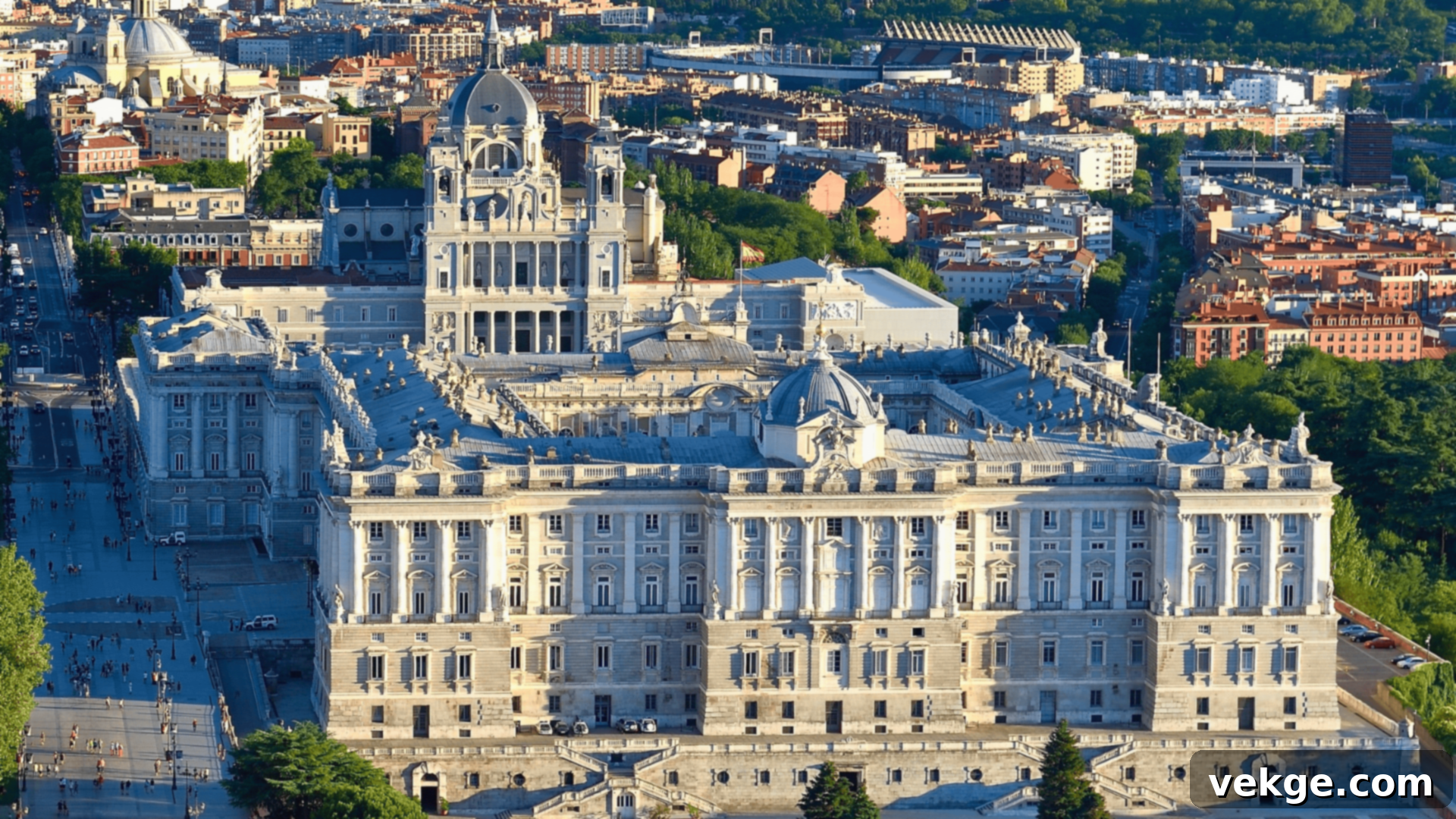
The Royal Palace of Madrid, the official residence of the Spanish Royal Family, is a breathtaking example of 18th-century Baroque and Neoclassical architecture, and proudly stands as the largest royal palace in Western Europe. Built between 1738 and 1755 on the site of the former Alcázar, it boasts over 3,000 opulent rooms. Inside, visitors can marvel at the lavish royal halls, intricately painted ceilings by master artists like Giambattista Tiepolo and Anton Raphael Mengs, and an astonishing collection of fine decorations, including tapestries, porcelain, and armor from the Royal Armory. Though the Royal Family now resides elsewhere, the palace is still actively used for state ceremonies and diplomatic functions, offering a magnificent glimpse into Spain’s regal history and artistic patronage.
Best Times to Visit: March to May and September to November offer mild weather and smaller crowds, ideal for a comprehensive tour of the palace and its extensive grounds.
Visiting Hours: Open daily, usually from 10 AM to 6 PM in winter and 10 AM to 7 PM in summer. Always check for closures during official events or state visits.
13. El Escorial Monastery – San Lorenzo de El Escorial
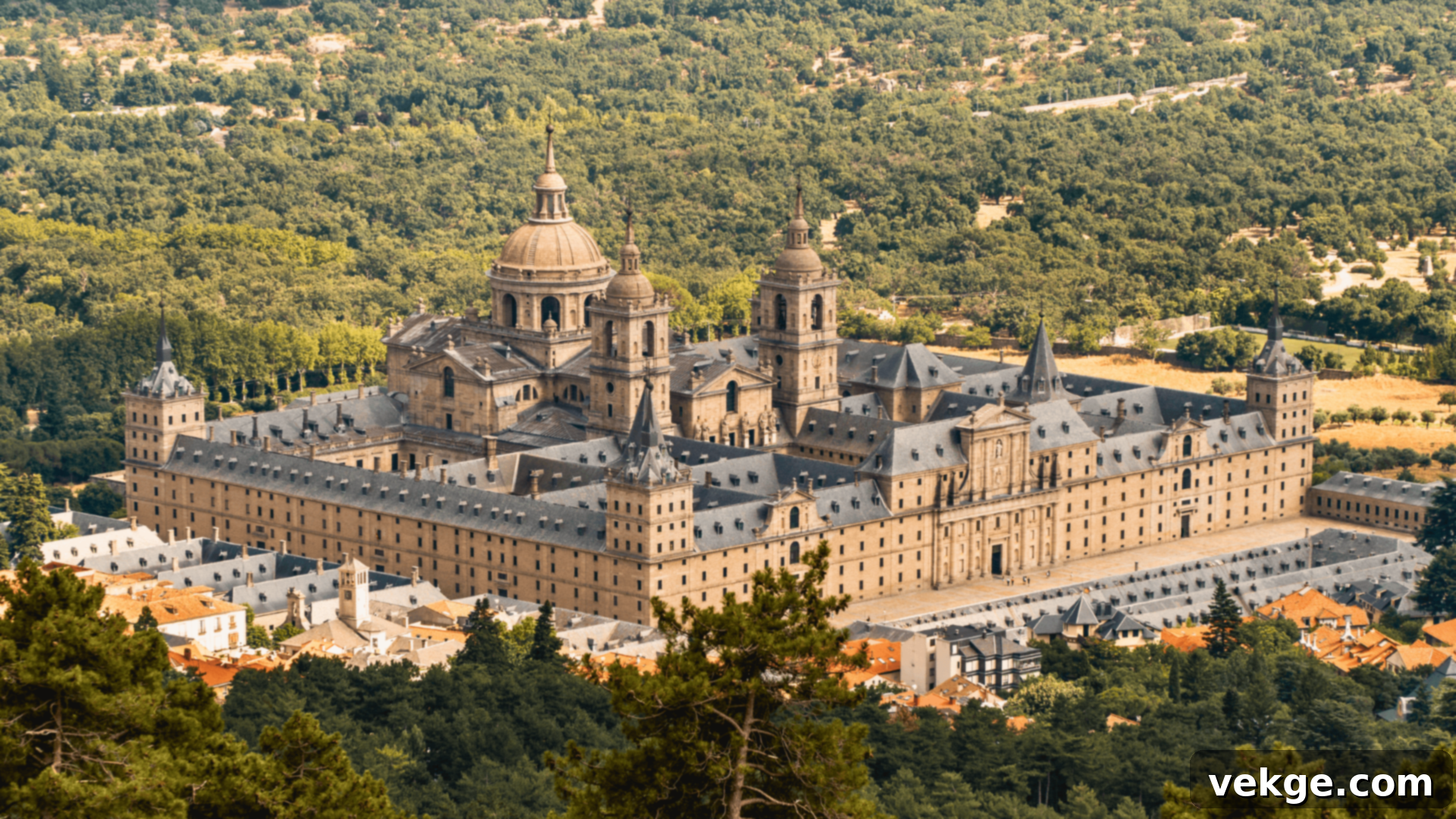
San Lorenzo de El Escorial is an immense and austere complex that perfectly embodies the power and religious devotion of Spain during its Golden Age. Commissioned by King Philip II and built in the late 16th century, it is a harmonious, yet monumental, blend of palace, monastery, basilica, royal pantheon, library, and museum. This UNESCO World Heritage site is a masterpiece of Herrera style, named after its principal architect Juan de Herrera, characterized by its severe classical lines, granite construction, and slate roofs, reflecting the monarch’s ascetic tastes. While deceptively simple on the outside, its interior is rich with history, art by masters like El Greco and Titian, and the crypts of many Spanish monarchs, reflecting the monarch’s vision of a center for both spiritual contemplation and imperial administration.
Best Times to Visit: Spring and early fall are best for walking the extensive grounds and enjoying the surrounding mountain scenery comfortably, avoiding the summer heat and winter chill.
Visiting Hours: Open Tuesday to Sunday, typically from 10 AM to 6 PM (winter) or 7 PM (summer). Closed on Mondays and some holidays, so verify before planning your visit.
14. Plaza Mayor – Madrid

Madrid’s iconic Plaza Mayor is a grand arcaded square, a quintessential example of Hapsburg-era urban planning and harmonious Baroque architecture. Constructed primarily in the early 17th century during the reign of Philip III (whose equestrian bronze statue stands proudly at its center), this vast rectangular space has been the vibrant heart of Madrid life for centuries. It has witnessed everything from bustling markets and thrilling bullfights to solemn public executions, grand royal proclamations, and lively festivals. Surrounded by uniform red buildings with elegant balconies and nine access arches, it remains a bustling and popular public space where locals and tourists alike gather to enjoy outdoor cafés, soak in the vibrant city atmosphere, and appreciate its enduring historical significance as a living monument to Madrid’s past.
Best Times to Visit: Go in late spring or early autumn to enjoy the pleasant weather, perfect for outdoor cafés, people-watching, and various public events that often take place here.
Visiting Hours: Open to the public at all times, offering a continuous stage for Madrid’s dynamic street life and historical ambiance.
15. University of Salamanca – Salamanca
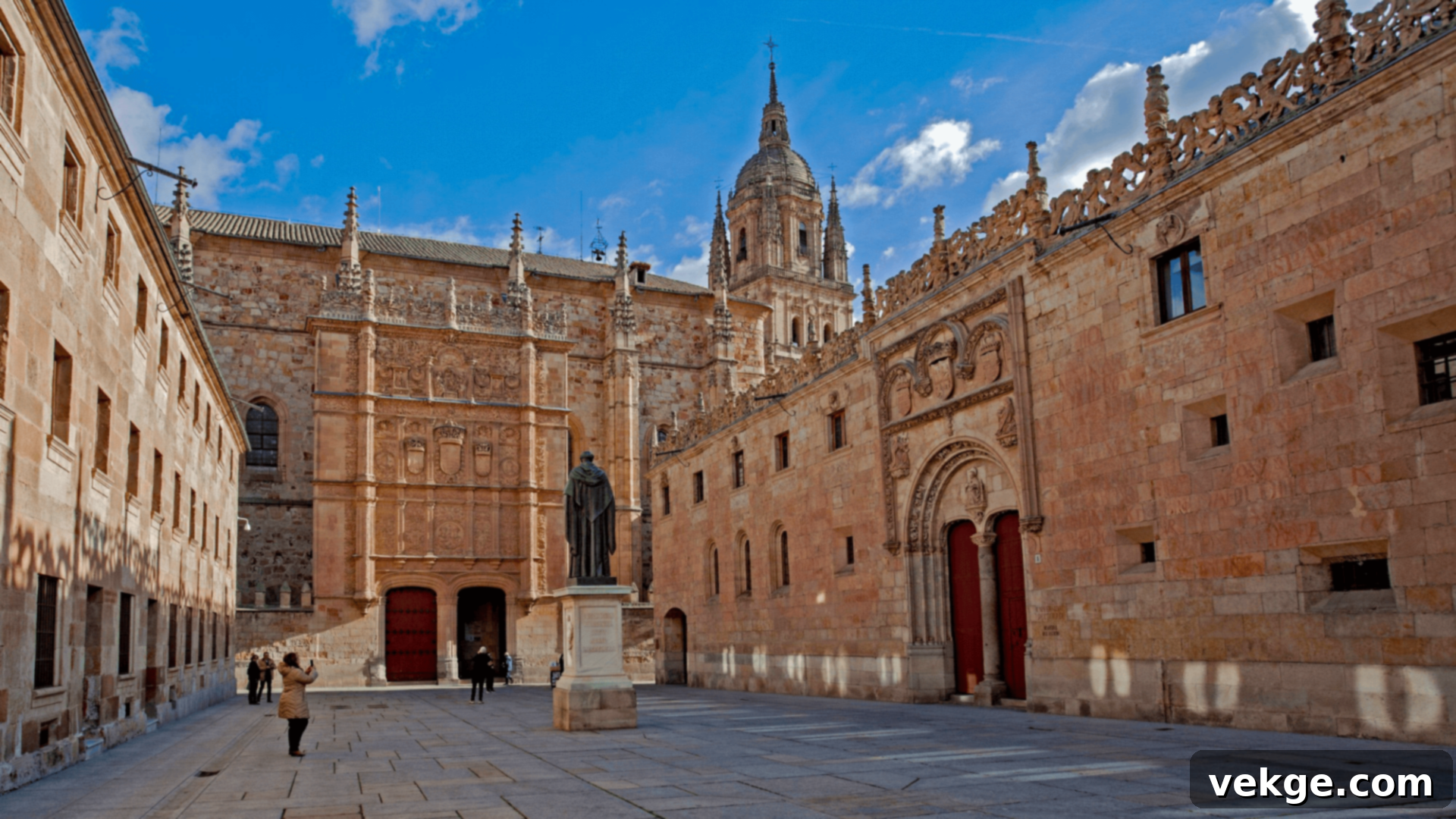
Founded in 1218, the University of Salamanca is one of the oldest and most prestigious universities in Europe, a bastion of learning that has attracted scholars and illuminated minds for centuries. Its historical buildings, a UNESCO World Heritage site, are a breathtaking blend of Gothic, Renaissance, and Plateresque styles, creating a rich architectural tapestry. The university’s most famous architectural feature is its incredibly detailed Plateresque facade of the main building, a masterpiece of intricate stone carving. Visitors often engage in a delightful tradition: trying to spot a tiny carved frog nestled amidst the myriad of decorations on the facade, believed to bring good luck to students. This historic campus is not only an academic institution but also a living museum of architectural artistry and intellectual heritage.
Best Times to Visit: April to June and September are excellent for exploring the historic town and enjoying the academic atmosphere, with comfortable temperatures for walking.
Visiting Hours: Open Monday to Saturday, with specific timings for different buildings and museums within the university. Guided tours are frequently available during the day, offering deeper insights.
16. Palacio de Carlos V – Alhambra complex, Granada
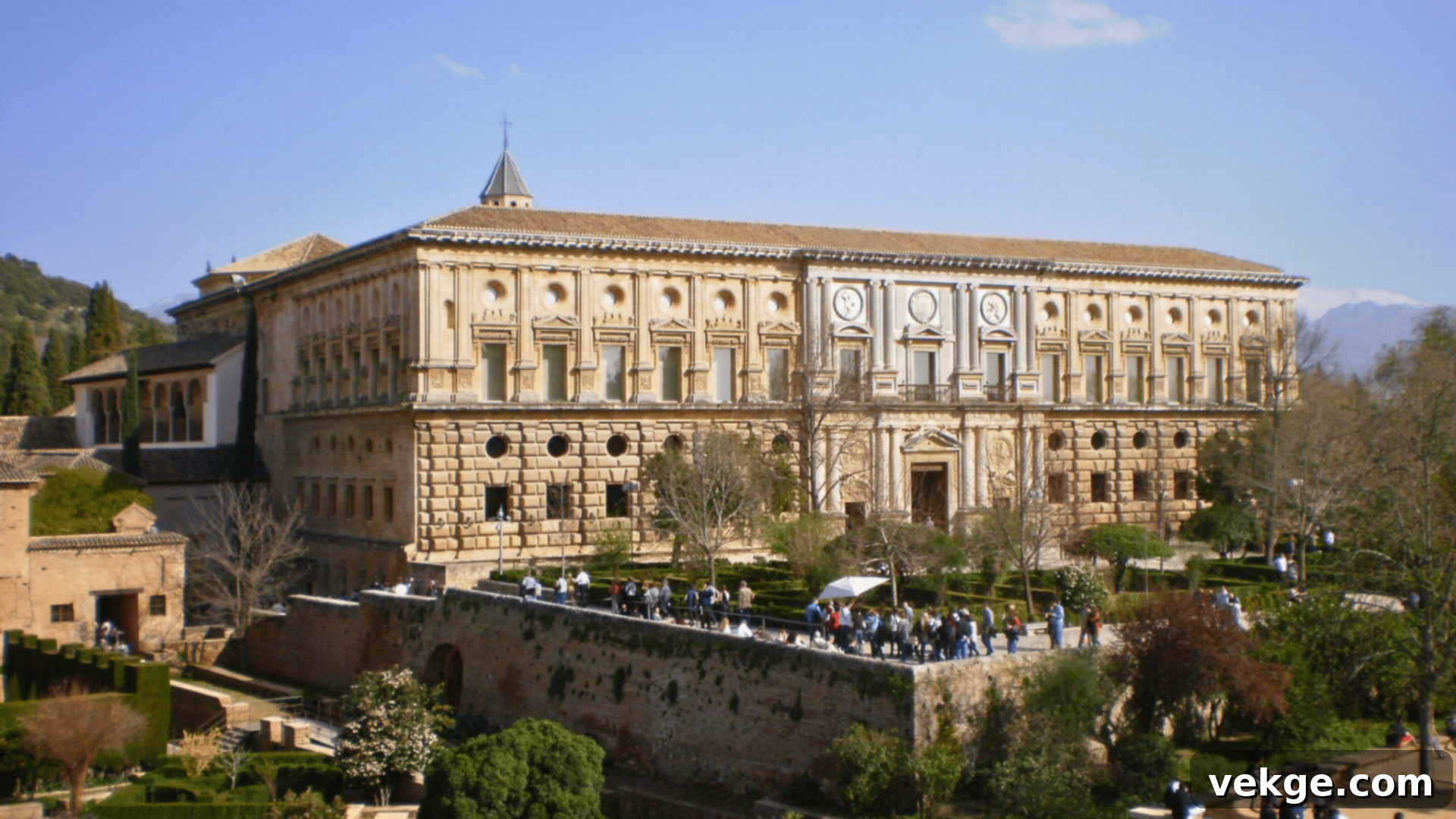
Within the heart of the Alhambra complex in Granada stands the Palacio de Carlos V, a striking example of High Renaissance architecture that presents a fascinating, almost audacious, contrast to the surrounding delicate Moorish palaces. Commissioned by Emperor Charles V in the 16th century after the Christian Reconquest, this robust stone palace features a monumental, perfectly circular courtyard enclosed by two tiers of classical colonnades, a unique design for its time and place. Its classical, symmetrical style stands in bold juxtaposition to the ornate, intricate Islamic buildings nearby, symbolizing a dramatic shift in power and artistic taste, yet it remarkably coexists within the same historic UNESCO-listed site. Today, it houses the Alhambra Museum and the Museum of Fine Arts of Granada.
Best Times to Visit: Best seen from April to June or in September when visiting the Alhambra, as it’s an integral part of the same complex and covered by the same ticket.
Visiting Hours: Open daily. Entry to the palace exterior and courtyard is often included with general Alhambra tickets; museums inside may have separate hours.
Modernist / Gaudí Masterpieces: Organic Forms and Vibrant Imagination
Barcelona stands as the undisputed capital of Modernist architecture in Spain, a movement known for its distinctive rejection of industrial uniformity and its passionate embrace of organic forms, vibrant colors, and intricate detailing. At the forefront of this revolution was Antoni Gaudí, whose whimsical, nature-inspired, and often surreal designs defy easy categorization. His groundbreaking work, often inspired by natural elements and religious symbolism, transformed the urban landscape, making Barcelona a living museum of architectural innovation, where buildings seem to breathe with life and tell fantastical stories. His creations are now UNESCO World Heritage sites.
17. Sagrada Familia – Barcelona
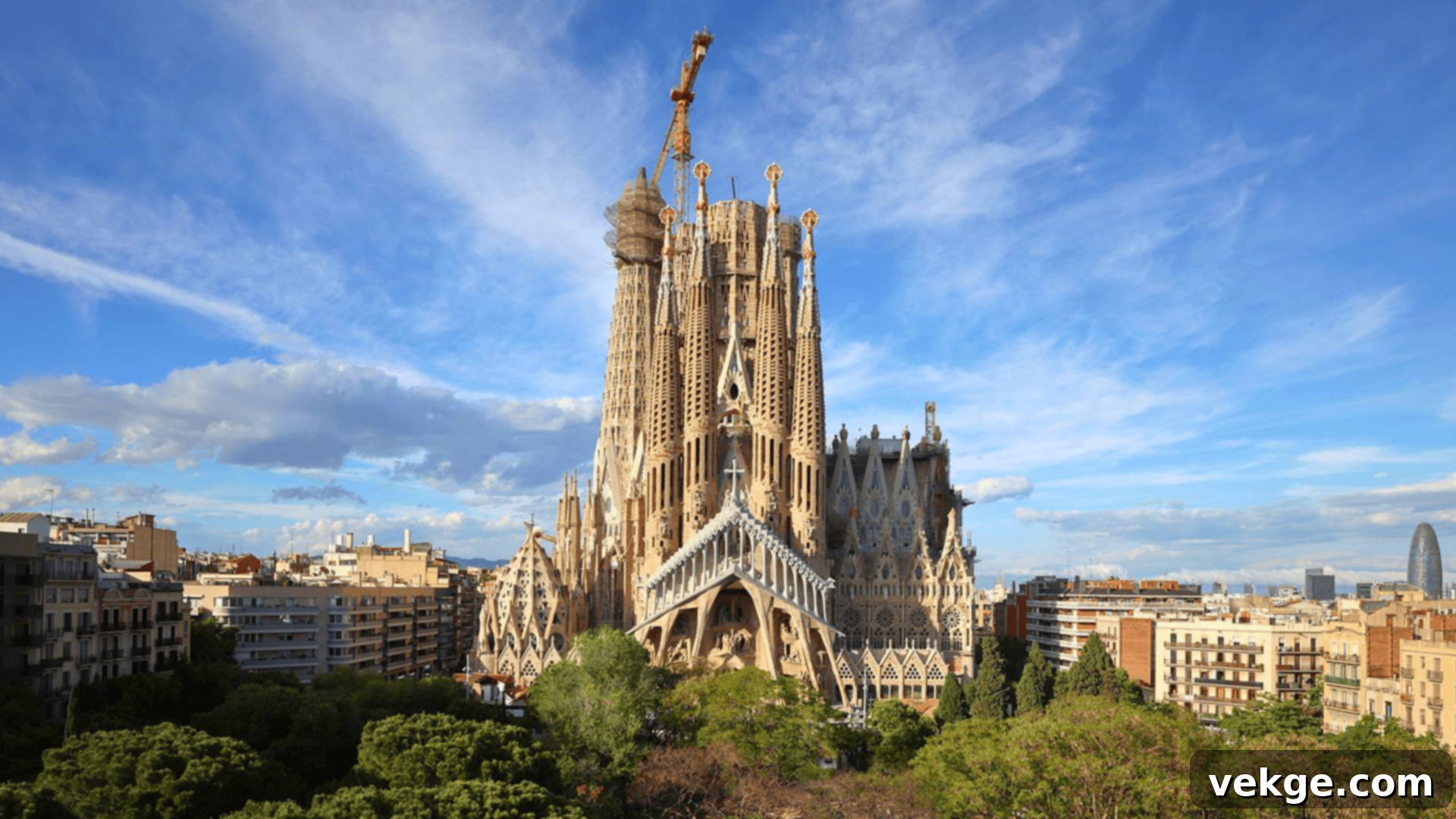
La Sagrada Familia, Antoni Gaudí’s magnum opus, is undoubtedly the most iconic and ambitious architectural project in Spain, perhaps even the world. This colossal basilica has been under continuous construction since 1882, an enduring testament to faith, artistic vision, and structural audacity. Gaudí dedicated the latter part of his life to this project, imbuing it with profound Christian symbolism and his signature organic, nature-inspired forms. It features three grand facades (Nativity, Passion, and Glory), each a complex tapestry of sculpted figures and architectural elements, soaring towers that pierce the sky, and an interior bathed in the kaleidoscope of light from its stunning stained-glass windows, resembling a vibrant forest. Its eventual completion, anticipated in the coming years, will mark a monumental achievement in architectural history and a testament to human perseverance.
Best Times to Visit: March to May or September to November are great for smaller crowds and more pleasant weather, enhancing the visiting experience both inside and out.
Visiting Hours: Open daily, usually from 9 AM to 6 PM, with hours potentially varying by season. Booking tickets in advance online is highly recommended due to its immense popularity.
18. Casa Batlló – Barcelona
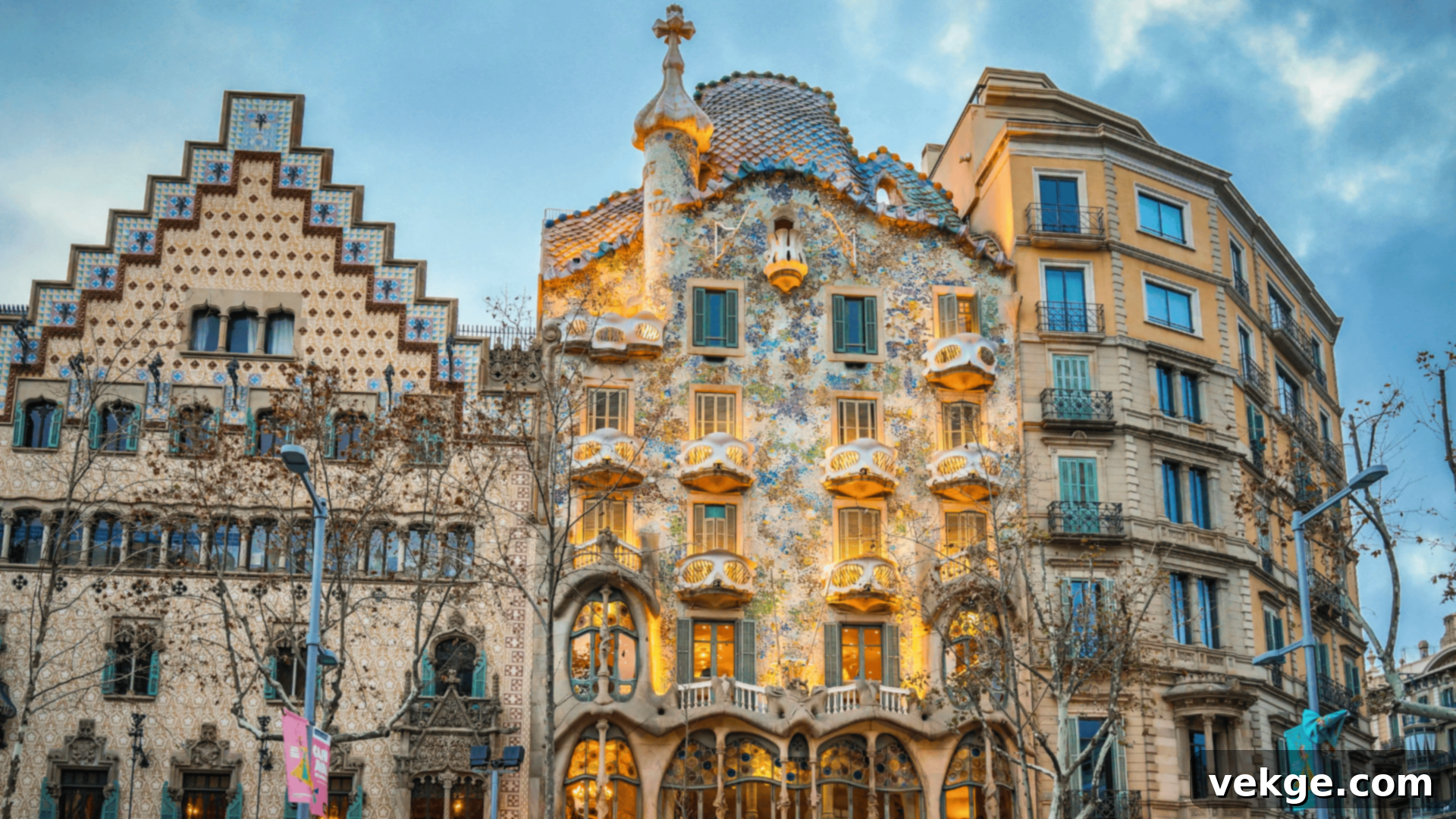
Often referred to as the “House of Bones” or “House of the Dragon” due to its skeletal appearance, Casa Batlló is a brilliant and playful building that seems to leap straight from the pages of a fairy tale. Gaudí completely remodelled this former conventional residence between 1904 and 1906, transforming it into an organic masterpiece recognized as a UNESCO World Heritage site. Its facade shimmers with vibrant mosaic tiles (trencadís) that change color with the light, while its wavy, undulating walls mimic the gentle motion of the sea. The roof, resembling the scales of a dragon’s back and topped with a lance-like turret, hints at the legend of Saint George and the Dragon. Every detail, from its marine-inspired interior to its unique, eye-shaped windows, showcases Gaudí’s boundless imagination and profound connection to nature, making it a truly immersive experience.
Best Times to Visit: Go between March and June or in the fall for a more relaxed visit, avoiding peak summer crowds and enjoying comfortable temperatures.
Visiting Hours: Open daily, typically from 9 AM to 8 PM. Evening experiences and guided tours are also often available for a different perspective.
19. Casa Milà (La Pedrera) – Barcelona
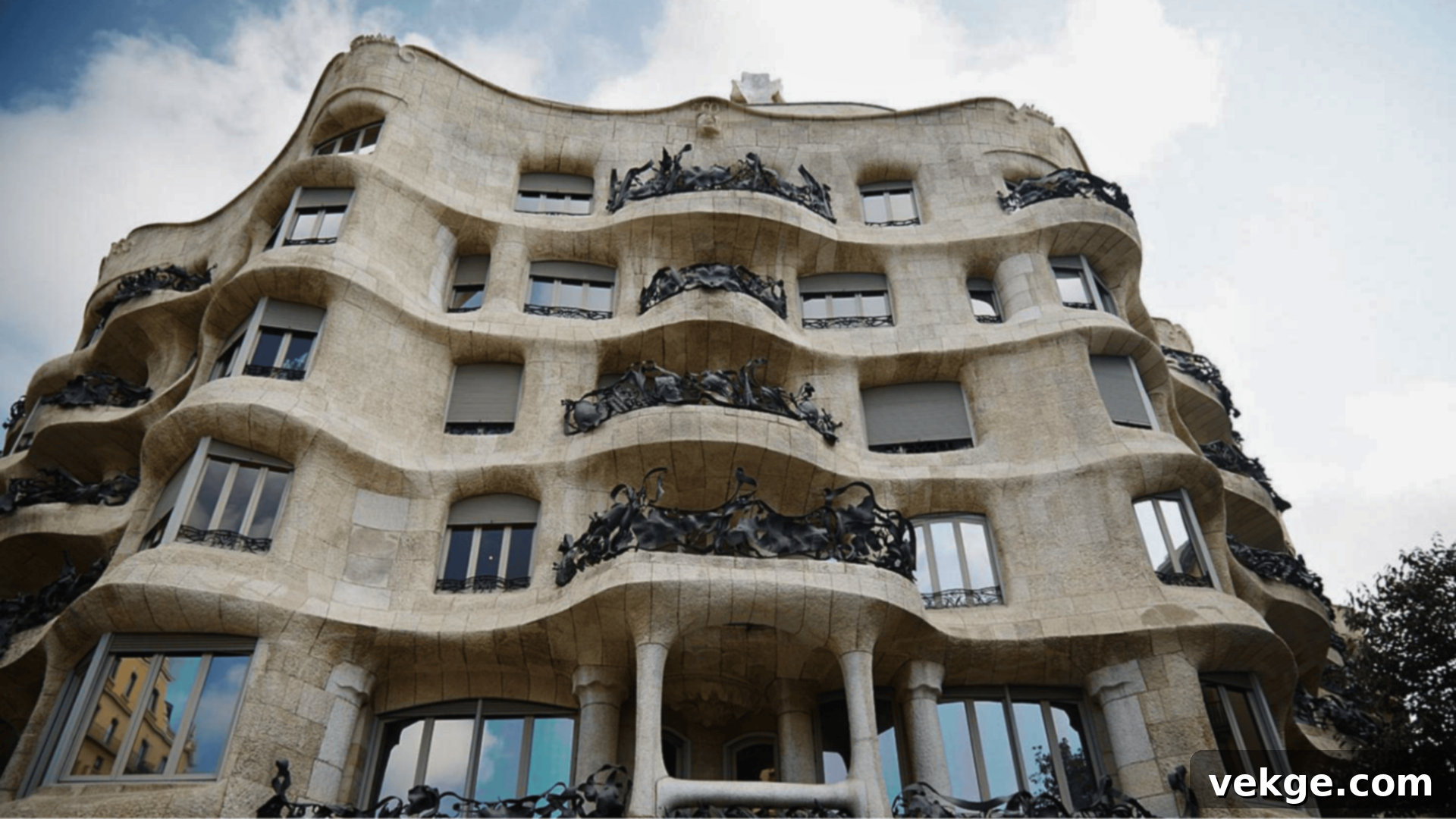
Also known as “La Pedrera” (The Stone Quarry) due to its rough, undulating facade, Casa Milà is another of Gaudí’s iconic residential buildings, completed in 1912 and also a UNESCO World Heritage site. It stands as a revolutionary work of Modernisme, notable for its innovative, self-supporting stone facade, which allowed for an open-plan interior and an unprecedented underground garage. The building’s organic, wave-like form seems to defy conventional architecture, devoid of straight lines, while its twisting wrought-iron balconies resemble seaweed or creeping vines. The rooftop is a fantastical landscape populated by an army of sculptural chimney stacks and ventilation shafts, which double as artistic elements and “warriors,” offering breathtaking panoramic views over Barcelona. It was one of Gaudí’s last private residential works before he fully dedicated himself to the Sagrada Familia.
Best Times to Visit: Visit in spring or early fall to avoid the intense summer heat and enjoy comfortable exploration of both its interiors and the spectacular rooftop.
Visiting Hours: Open every day, usually from 9 AM to 8:30 PM, with night experiences and guided tours also available for a unique perspective.
20. Parc Güell – Barcelona
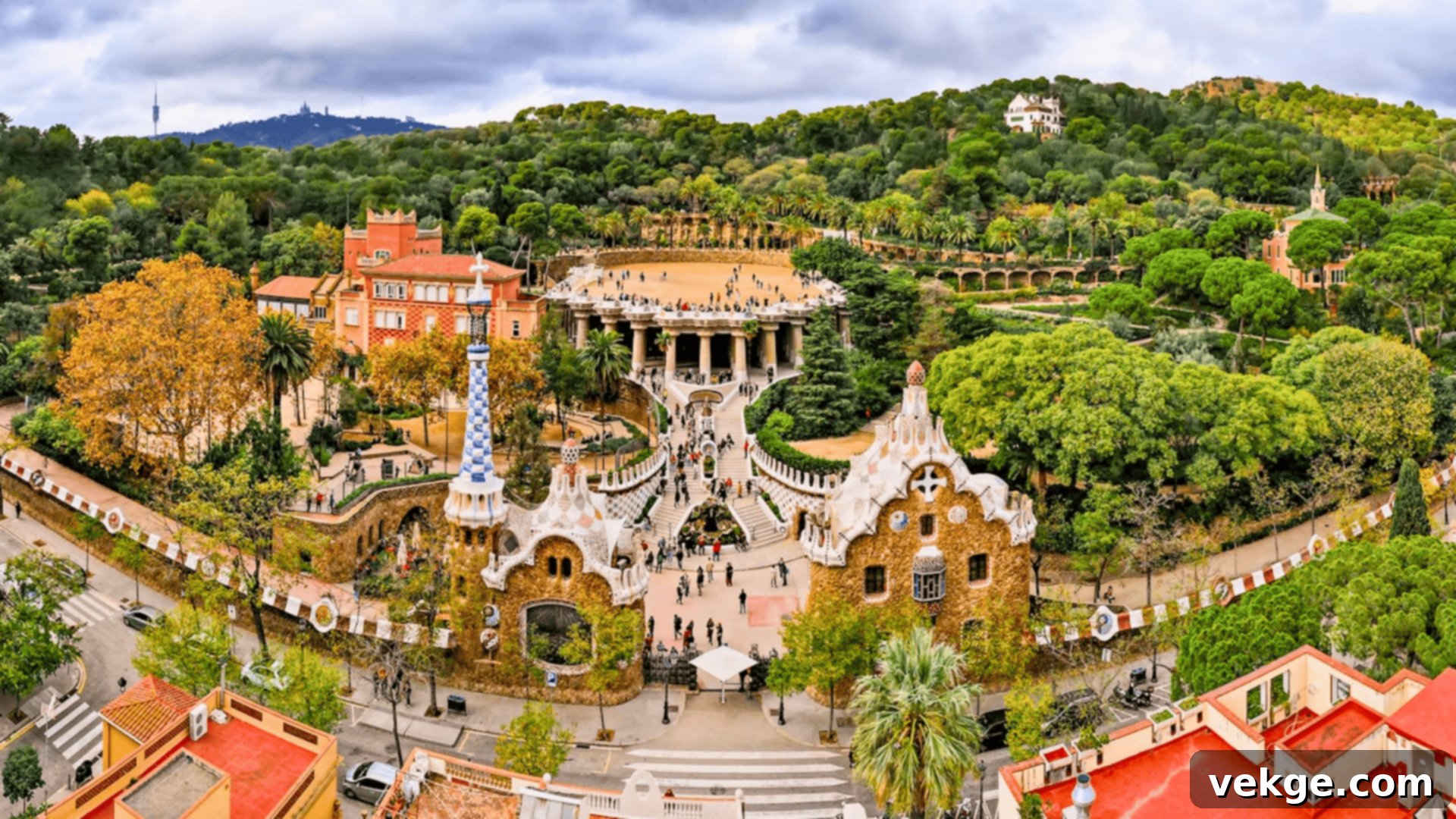
A vibrant public park system composed of gardens and architectural elements, Parc Güell is a UNESCO World Heritage site and a dazzling example of Antoni Gaudí’s imaginative urban planning and design. Originally conceived between 1900 and 1914 as a utopian housing estate for the wealthy Eusebi Güell, it was later transformed into a public park. The park is a joyous riot of color and whimsical forms, featuring iconic mosaic benches crafted using the intricate trencadís technique, playful gingerbread-house-like gatehouses, and the famous mosaic salamander (or dragon) at the entrance, a symbol of the park. Its unique integration with the natural landscape and stunning panoramic views of Barcelona make it a beloved destination for both locals and tourists, embodying Gaudí’s visionary concept of harmony between nature and architecture.
Best Times to Visit: Early spring or late fall are ideal for fewer visitors and cooler weather, perfect for leisurely strolls through its extensive grounds and enjoying the views.
Visiting Hours: Open daily, generally from 9:30 AM to 7:30 PM, with seasonal variations. Booking online in advance is essential for access to the Monumental Zone, which contains most of Gaudí’s key works.
21. Palau Güell – Barcelona

Palau Güell, an earlier but significant work by Antoni Gaudí (1886-1888) for his patron Eusebi Güell, is a fascinating precursor to his later, more flamboyant masterpieces and a UNESCO World Heritage site. This city mansion, located near La Rambla, showcases Gaudí’s burgeoning talent and innovative approach to light and space within a relatively confined urban plot. It combines dark, solid stone with elaborate wrought-iron work, particularly notable in its parabolic entrance arches that cleverly allowed horse-drawn carriages to enter directly. The interior is designed around a grand central hall that extends up through multiple stories to a parabolic dome, allowing natural light to penetrate deeply into the heart of the building. The rooftop is a highlight, featuring an array of vibrant, fantastically shaped chimneys adorned with colourful ceramic tiles, demonstrating Gaudí’s playful experimentation with sculptural elements from the outset of his career.
Best Times to Visit: Best seen in spring or autumn when the city is less crowded, offering a more intimate viewing experience of this early Modernist gem.
Visiting Hours: Open Tuesday to Sunday, often from 10 AM to 5:30 PM. Check for specific closure dates, especially around holidays.
22. Casa Vicens – Barcelona

Casa Vicens holds a significant place in the narrative of Antoni Gaudí’s career as his very first major residential commission, completed between 1883 and 1885. This vibrant and eclectic house, also a UNESCO World Heritage site, beautifully blends elements of Oriental and Mudejar styles with Gaudí’s burgeoning organic vision. It’s a riot of color, adorned with intricate green and white ceramic tiles arranged in a checkerboard pattern, inspired by the marigold flowers found on the original site. The detailed ironwork, exposed brickwork, and plant motifs demonstrate Gaudí’s early fascination with nature and his ability to integrate various artistic influences into a harmonious, unique whole, laying the groundwork for his future masterpieces and showcasing his inventive approach to residential design.
Best Times to Visit: Go from April to June or September to November for a calmer and more comfortable visit, avoiding peak season crowds and enjoying milder weather.
Visiting Hours: Open daily, typically from 10:00 AM to 8:00 PM, with last entry usually an hour before closing. It is advisable to book tickets online.
23. Hospital de Sant Pau – Barcelona

While Gaudí is the most famous, he was not the only luminary of Catalan Modernisme. The Hospital de Sant Pau, a UNESCO World Heritage site, is a magnificent testament to the genius of Lluís Domènech i Montaner. Constructed between 1901 and 1930, this former hospital complex looks less like a medical facility and more like a fantastical, vibrant castle or an enlightened garden city. Designed with the radical idea of providing patients with light, air, and beautiful surroundings for healing, it features an array of exquisitely decorated pavilions connected by underground tunnels and surrounded by peaceful gardens. Its colorful tiles, intricate sculptures, and beautiful mosaics make it a breathtaking and serene architectural escape in the heart of Barcelona, showcasing a humanitarian approach to Modernist design.
Best Times to Visit: Visit in spring or fall for mild weather and fewer crowds, allowing for relaxed exploration of the extensive grounds and stunning interiors.
Visiting Hours: Open daily, generally from 10 AM to 6:30 PM. Check the official website for current exhibition and tour timings, as some areas may be subject to availability.
Contemporary & Avant-Garde: Innovation and Future Visions
Spain continues to assert its position at the forefront of global architectural innovation, consistently embracing bold shapes, pioneering high-tech materials, and fresh, avant-garde ideas. The buildings from this contemporary era are not just structures; they are powerful statements that challenge conventions and redefine urban landscapes, often serving as catalysts for urban regeneration. With their striking forms, often sculptural and fluid, and visionary designs, these places stand out dramatically in modern city skylines, symbolizing Spain’s ongoing commitment to pushing the boundaries of creative and functional design in the 21st century.
24. Guggenheim Museum – Bilbao
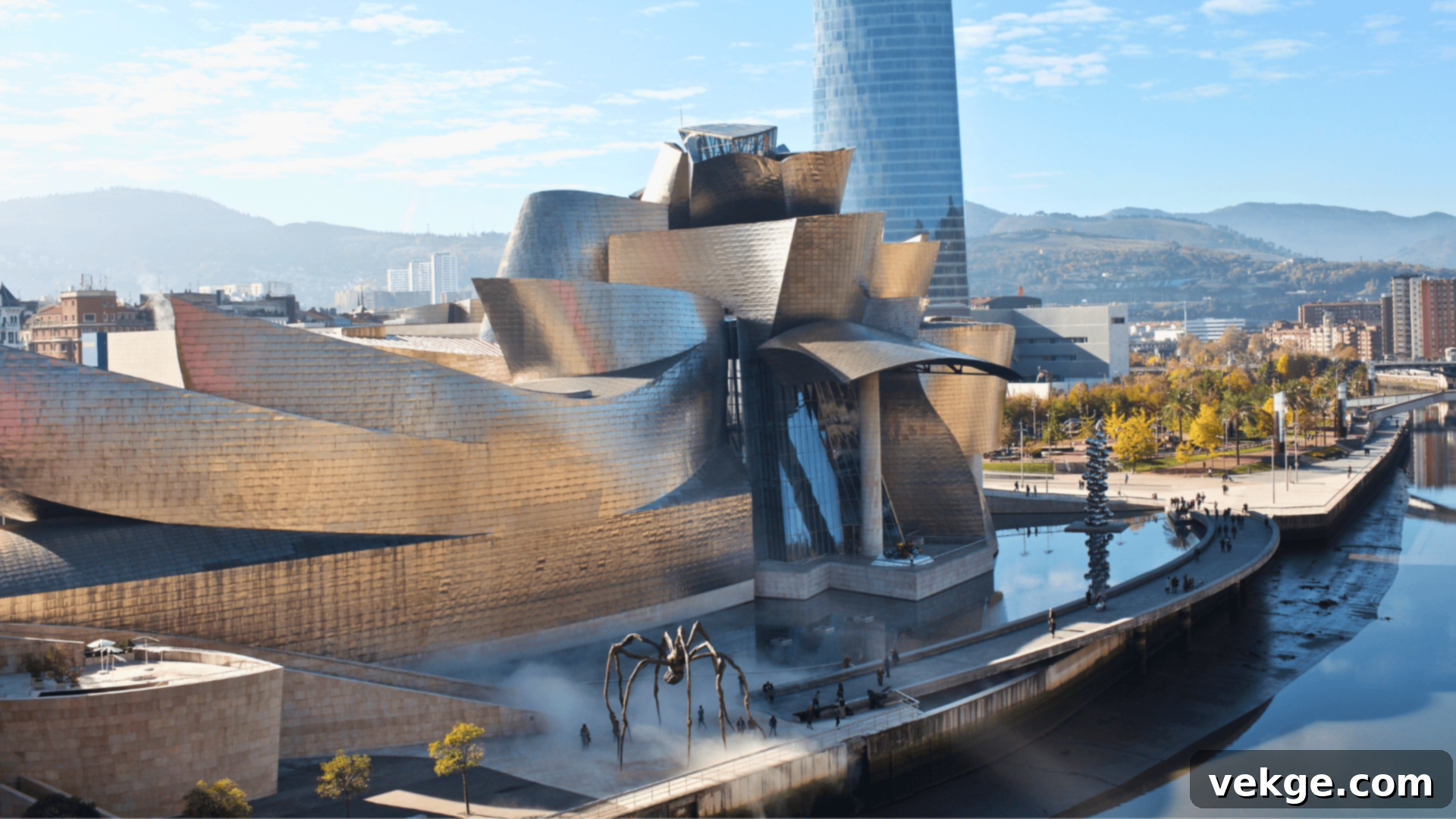
Frank Gehry’s Guggenheim Museum in Bilbao is nothing short of a modern architectural icon, a dazzling sculpture crafted from flowing sheets of titanium, glass, and stone. Opened in 1997, its fluid, deconstructivist forms immediately captured global attention, sparking the famous “Bilbao Effect” – a phenomenon where a single building revitalizes an entire city’s economy and image. The museum dramatically transformed Bilbao from an industrial city into a thriving cultural and tourist destination, attracting millions of visitors annually. Its shimmering exterior reflects the changing light of the Nervión River, making the building itself a dynamic work of art that seamlessly blends with its urban and natural surroundings, housing an impressive collection of modern and contemporary art and permanently altering the urban landscape.
Best Times to Visit: May to October is ideal for walking along the river, enjoying the outdoor sculptures (like Jeff Koons’ ‘Puppy’), and exploring nearby sights in pleasant weather.
Visiting Hours: Open Tuesday to Sunday, typically from 10 AM to 7 PM. Closed on Mondays, except during peak season months (July and August) or major holidays.
25. City of Arts and Sciences – Valencia

Designed by the visionary Spanish architect Santiago Calatrava, the City of Arts and Sciences in Valencia is a colossal and awe-inspiring complex that appears to have landed straight from a futuristic sci-fi movie. This sprawling cultural and architectural ensemble, constructed in the former riverbed of the Turia, includes a planetarium (L’Hemisfèric), an interactive science museum (Museu de les Ciències Príncipe Felipe), an opera house (Palau de les Arts Reina Sofía), and one of Europe’s largest aquariums (Oceanogràfic). Its distinctive white, skeletal structures, often featuring reflecting pools that mirror their graceful forms, evoke images of marine life, giant bones, or spaceships, creating a harmonious yet spectacular blend of art, science, and nature. It has become a powerful symbol of modern Valencia and a true marvel of 21st-century architecture.
Best Times to Visit: Spring and fall offer excellent weather for walking between the various buildings, enjoying the outdoor spaces, and exploring each attraction comfortably.
Visiting Hours: Each individual component of the complex has different operating hours, but most areas open around 10 AM. It’s advisable to check the specific times for each attraction you plan to visit.
26. Setas de Sevilla (Metropol Parasol) – Seville
Dominating the Plaza de la Encarnación in Seville, the Setas de Sevilla, affectionately nicknamed “The Mushrooms of Seville” or Metropol Parasol, is a monumental wooden structure that radically redefines urban public space. Designed by Jürgen Mayer H. and completed in 2011, it is one of the largest wooden constructions in the world, resembling a giant waffle-like canopy of interconnected parasols that provide much-needed shade in Seville’s hot climate. It functions as a multi-level complex: housing an archaeological museum (Antiquarium) in its basement, a bustling central market on the ground level, and panoramic walkways on top that offer unparalleled 360-degree views of Seville. It represents a bold fusion of ancient history and cutting-edge contemporary design, providing both functional utility and a spectacular viewpoint.
Best Times to Visit: March to May or September to November for cooler weather, ideal for exploring the city’s historic sites and enjoying the rooftop views during sunset.
Visiting Hours: Open daily, often from 9:30 AM to midnight for rooftop access, with slightly varied hours for the market and museum components.
27. Torre Glòries (formerly Torre Agbar) – Barcelona
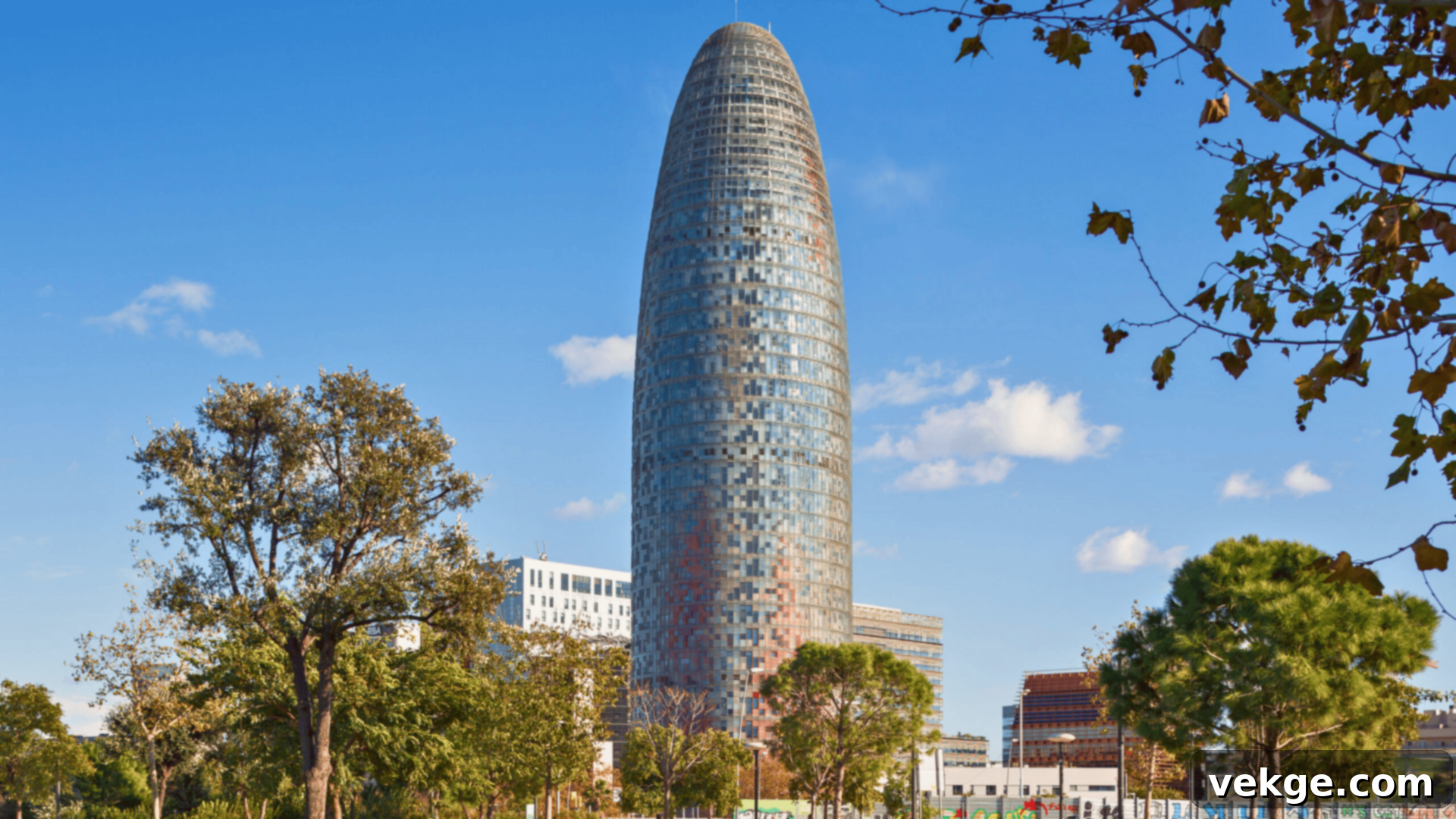
An unmistakable feature of Barcelona’s modern skyline, the Torre Glòries (originally Torre Agbar) is a soaring, bullet-shaped skyscraper designed by French architect Jean Nouvel. Completed in 2005, its innovative design incorporates a distinctive dual skin of glass and aluminium panels in varying shades, giving the tower a colorful, almost iridescent appearance that changes with the light. At night, it transforms into a magnificent spectacle, illuminated by thousands of LED lights that can create complex patterns and shifting colors, adding a dynamic and artistic touch to the city’s nocturnal landscape. Symbolizing Barcelona’s forward-looking spirit and its commitment to bold design, it’s a prominent and iconic emblem of contemporary architecture, standing tall in the Sant Martí district.
Best Times to Visit: Evening visits offer the most spectacular view when the tower is fully illuminated, creating a magical atmosphere against the night sky.
Visiting Hours: While interior access is typically limited to offices, visitors can admire the building from the outside at all times. An observation deck and exhibition are available to the public for a fee.
28. W Hotel (Hotel Vela) – Barcelona
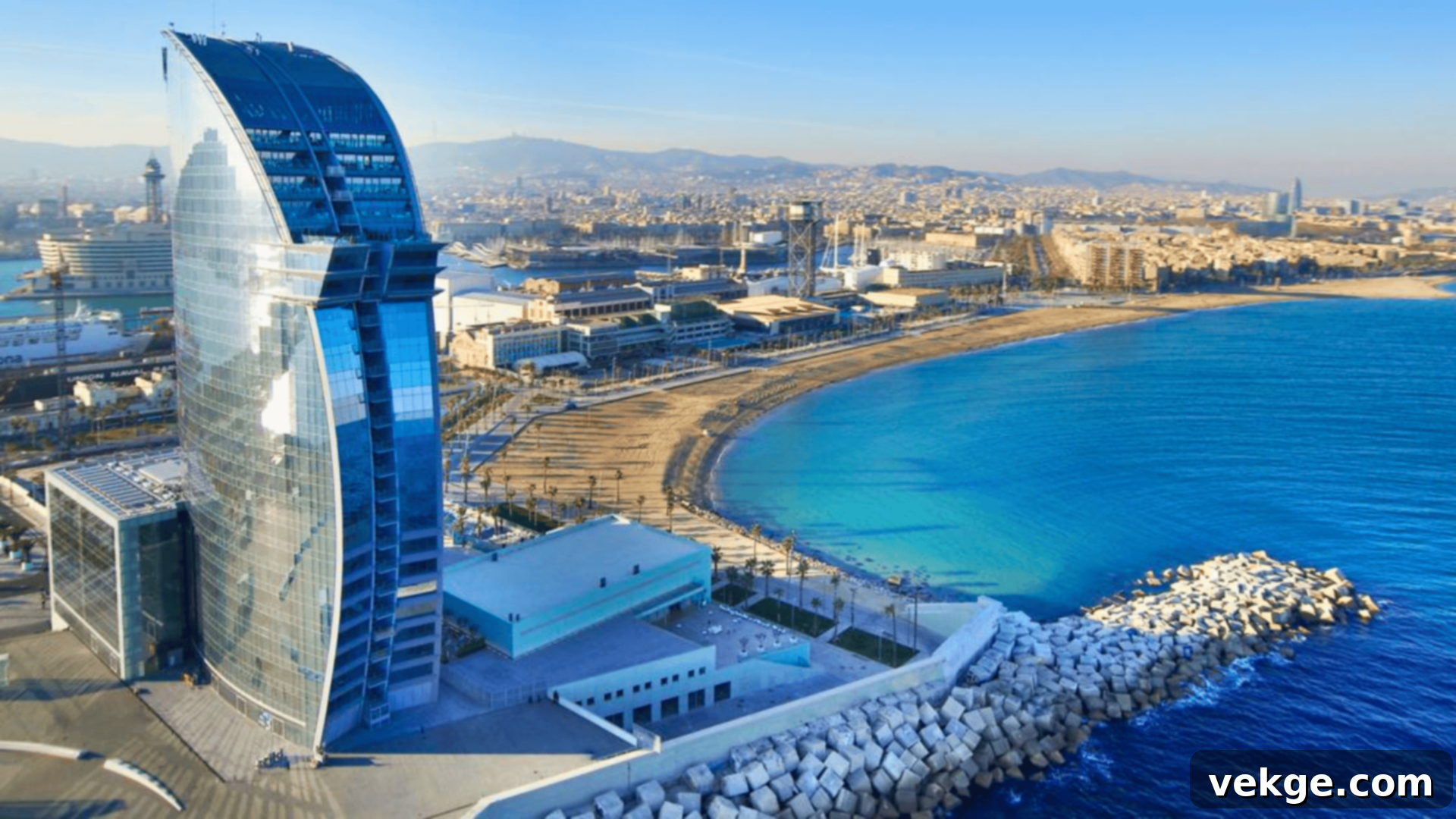
Gracing the entrance to Barcelona’s port and beachfront, the W Hotel, popularly known as Hotel Vela (Sail Hotel), is a stunning architectural statement designed by Ricardo Bofill. Its distinctive sail-like shape and shimmering glass exterior make it an instantly recognizable landmark along the Mediterranean coastline. Completed in 2009, this luxurious hotel provides panoramic ocean views from nearly every angle, creating an immersive experience of sea and sky. The building’s sleek, contemporary lines and reflective surfaces perfectly capture the essence of modern Barcelona, blending high-end design with its vibrant maritime setting and offering direct access to the beach. It stands as a prominent feature of the city’s modern architectural landscape, a beacon of luxury and modern design at the edge of the sea.
Best Times to Visit: Summer and early fall are perfect for enjoying the beautiful beachfront area, the hotel’s amenities, and the lively atmosphere along the Barceloneta promenade.
Visiting Hours: Public areas like the lobby, bars, and restaurants are open daily for visitors. Room access and other facilities are exclusively for hotel guests.
29. Palau de les Arts Reina Sofia – Valencia
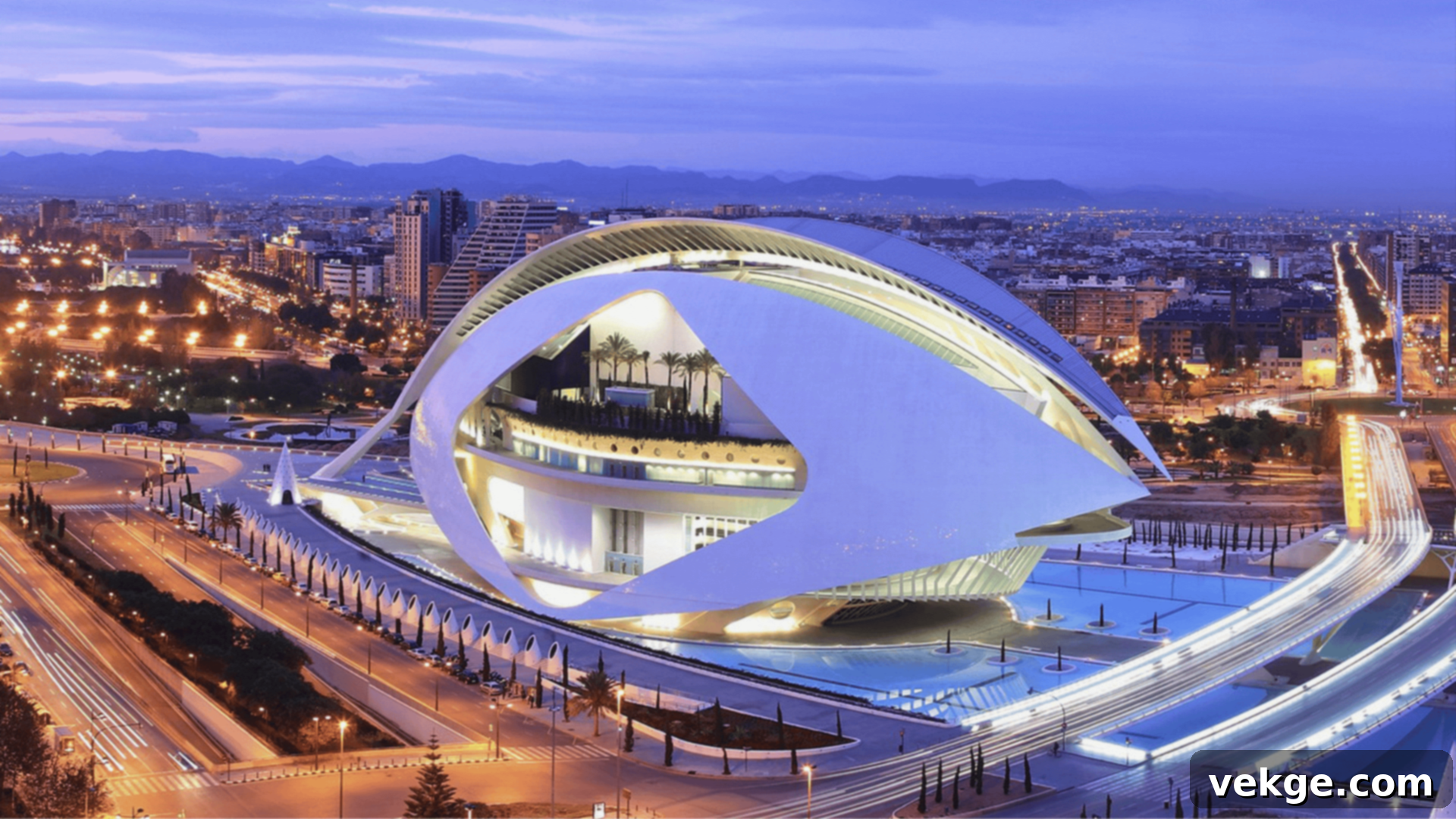
Also a fundamental part of Santiago Calatrava’s magnificent City of Arts and Sciences complex in Valencia, the Palau de les Arts Reina Sofía is a spectacular opera house and performing arts center. Its architectural design is breathtaking, resembling a giant, futuristic helmet, a majestic ship, or even a pre-historic fish with its sweeping white concrete and steel structure. Housing four separate auditoriums, it was meticulously designed to host a wide array of musical, theatrical, and operatic performances, boasting world-class acoustics. The Palau’s bold, eye-catching design, characterized by its elegant curves, monumental scale, and reflective surfaces, underscores Calatrava’s unique aesthetic, making it not just a venue for art, but a work of art in itself, celebrated for both its visual impact and functional excellence as a cultural beacon.
Best Times to Visit: Spring and fall are great for exploring the entire complex in comfortable weather, and ideally, attending a live show for the full experience of its interior and acoustics.
Visiting Hours: Guided tours are available most days for those interested in the architecture and history. Performance hours vary significantly based on the season’s program, so check ahead for tickets.
Castles & Historic Fortresses: Echoes of Royalty and Defense
Spain’s landscape is richly dotted with an impressive number of castles and historic fortresses, each telling a compelling story of conflict, royalty, and strategic defense. While primarily built for military purposes and protection against invaders, many of these formidable structures also possess a captivating, storybook quality with their imposing towers, robust stone walls, and commanding hilltop positions. Exploring these ancient strongholds offers a fascinating journey into the country’s rich royal and military past, allowing visitors to walk through centuries of history and imagine the lives of kings, queens, and knights, witnessing the architectural evolution of defensive structures.
30. Alcázar of Segovia – Segovia
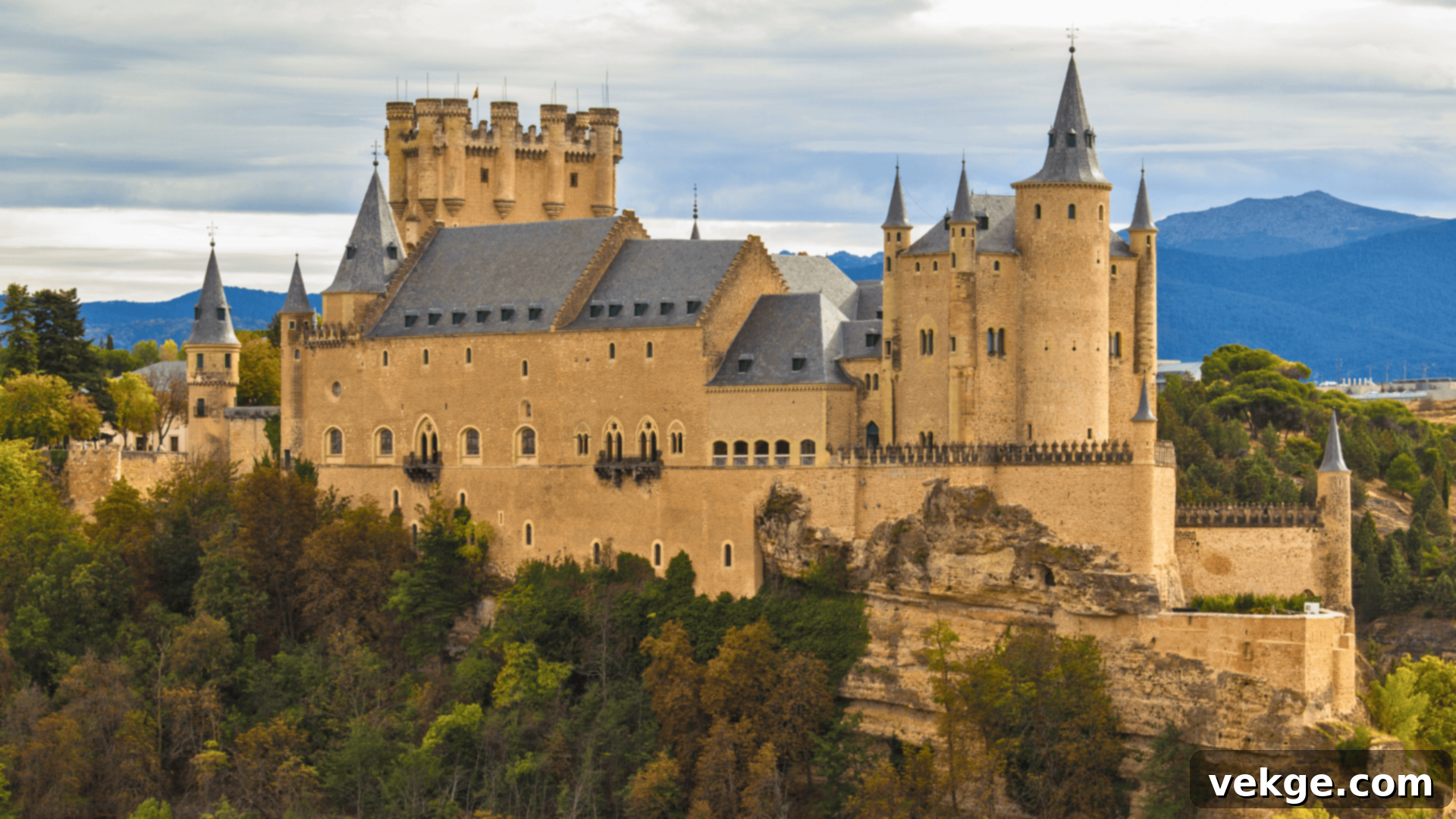
Rising dramatically from a rocky outcrop, the Alcázar of Segovia is perhaps the most quintessential fairytale castle in Spain, instantly recognizable with its pointed turrets, deep moat, and distinctive ship-like prow. Originally a Roman fort, it has served many roles over the centuries: a royal palace for Castilian monarchs (including Isabella I who was crowned here), a state prison, a Royal Artillery College, and today, a military archive and museum. Its elegant halls are rich with Mudejar-style ceilings, and the Hall of Kings showcases a frieze of Spanish monarchs. It is famously said to have inspired Walt Disney’s Cinderella Castle, making it one of the most photographed and beloved castles in all of Spain, embodying centuries of history, legend, and architectural charm. Its unique silhouette against the sky is truly unforgettable.
Best Times to Visit: April to June or September to October offer pleasant weather and fewer large tour groups, enhancing the visit to this magical site and the surrounding historic city.
Visiting Hours: Open daily, usually from 10 AM to 6 PM in winter and 10 AM to 8 PM in summer. Always confirm specific times for your visit, as they can vary seasonally.
31. Alcázar of Toledo – Toledo
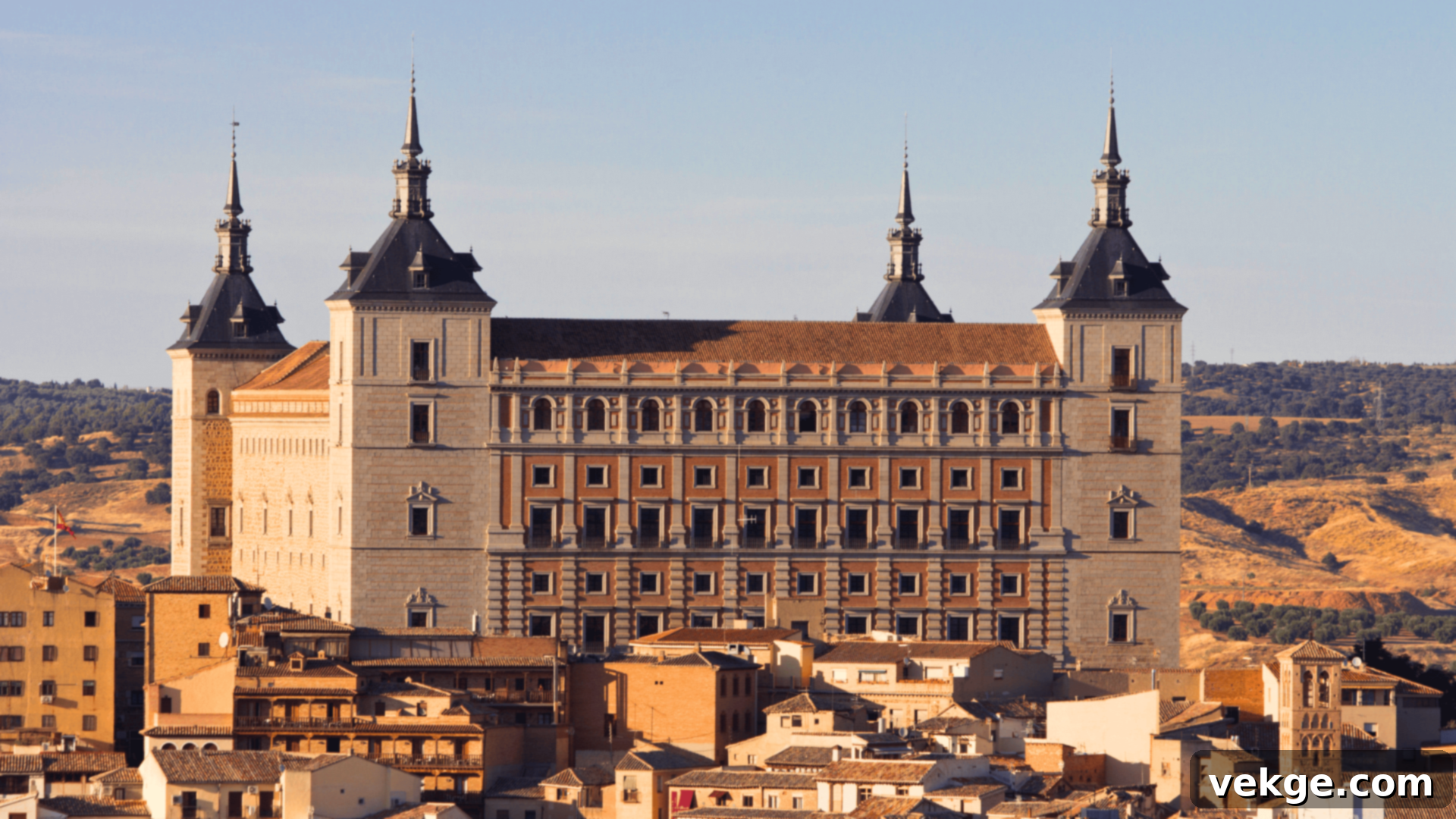
Perched atop the highest hill in the historic city of Toledo, the Alcázar of Toledo is an imposing stone fortification with a storied past stretching back to Roman times. Its strategic location has made it a crucial stronghold throughout history, serving successively as a Roman palace, a Visigothic fortress, a Moorish citadel, and later, a palace for Castilian kings. Rebuilt and expanded multiple times by various monarchs, its current Renaissance form largely dates from the 16th century. Deeply entwined with Spanish history, particularly its heroic siege during the Spanish Civil War, today it houses the Army Museum and offers unparalleled panoramic views over the ancient city, a UNESCO World Heritage site itself. It stands as a powerful symbol of Spanish resilience, military history, and architectural adaptation across different eras.
Best Times to Visit: Spring and fall are ideal for walking around Toledo’s charming, often hilly, old streets and enjoying the views without extreme temperatures or large crowds.
Visiting Hours: Open Tuesday to Sunday, often from 10 AM to 5 PM. Closed on Mondays and some public holidays, so plan your visit accordingly.
The Enduring Significance of Spain’s Architectural Landmarks
Beyond their sheer aesthetic beauty and impressive engineering, these architectural masterpieces are far more than mere structures of stone, brick, and glass. They are tangible narratives, each telling a profound story about Spain’s complex past, its dynamic culture, and the enduring spirit of its people. Every arch, every tower, every mosaic tile, every modern curve is a whisper from a different era, offering invaluable insights into the historical forces, artistic movements, and societal values that have shaped this vibrant nation.
Each landmark on this list distinctly represents a different chapter in Spain’s voluminous history. Some were meticulously constructed by powerful kings and queens to symbolize their imperial might and spiritual devotion, serving as centers of power and faith. Others were conceived by visionary artists and architects whose creativity pushed the boundaries of design, responding to changing philosophies and technological advancements. Together, they form a breathtaking timeline that allows us to witness the continuous evolution of art and design over centuries, from antiquity to the cutting edge of the present day.
This rich tapestry of styles — from the intricate geometry of Islamic arches and the soaring majesty of Gothic spires, to the elegant symmetry of Renaissance palaces, the whimsical, organic forms of Modernist masterpieces, and the sleek, bold lines of contemporary creations — illustrates how diverse cultures and artistic philosophies have converged and intertwined on the Iberian Peninsula. These buildings are not isolated structures but interconnected threads in a grand historical narrative, each influencing and responding to the others, creating a truly unique architectural landscape found nowhere else in the world.
What makes these sites even more appealing is their accessibility and profound impact. Many of these iconic landmarks are situated in Spain’s most vibrant cities—Madrid, Barcelona, Seville, Valencia—making them convenient additions to any travel itinerary, often located within easy reach of other major attractions. Others are found in picturesque, peaceful towns, offering a more serene exploration experience. Furthermore, a significant number of these sites, including the Alhambra, Burgos Cathedral, and the works of Antoni Gaudí, have been recognized with the prestigious UNESCO World Heritage status, affirming their universal cultural importance and ensuring their preservation for future generations.
Whether you are a student of history, an aspiring architect, an ardent art lover, an avid traveler planning your next adventure, or simply someone who appreciates cool and meaningful buildings, these architectural gems provide an unparalleled and deeper look into what truly makes Spain a unique and special country. They are more than just walls and windows; they are the enduring, living testaments to Spain’s remarkable story, inviting you to step inside and become a part of its unfolding legacy.
Conclusion: Your Journey Through Spain’s Architectural Legacy
You have now embarked on a comprehensive and captivating journey through a full list of Spain’s most famous and awe-inspiring architectural wonders. Each entry, from ancient Moorish fortresses echoing paradise to futuristic cultural complexes pushing the boundaries of design, comes with its own compelling story, distinct style, and undeniable reason to be explored in person.
As you reflect on this extraordinary collection, consider which buildings sparked your imagination the most. Perhaps you’ve already had the privilege of witnessing a few of these masterpieces, their grandeur leaving an indelible mark. Or maybe, this extensive guide has ignited a newfound desire, adding exciting, must-see destinations to your burgeoning travel plans, promising unforgettable experiences.
This guide is designed to be a timeless and practical resource, ready at your fingertips whenever you need a quick reminder of Spain’s architectural brilliance or wish to share these incredible spots with friends and fellow enthusiasts, inspiring their own adventures. Spain’s buildings transcend mere aesthetic appeal; they are powerful, tangible showcases of profound history, boundless creativity, and the enduring spirit of a rich and diverse culture, all harmoniously encapsulated within their magnificent structures.
Curious to delve even deeper into the wonders of Spain and beyond? We invite you to explore our other insightful blogs for a wealth of additional travel ideas, artistic design inspiration, and invaluable tips for experiencing the very best that Spain and the wider world have to offer. Let your architectural exploration continue!
